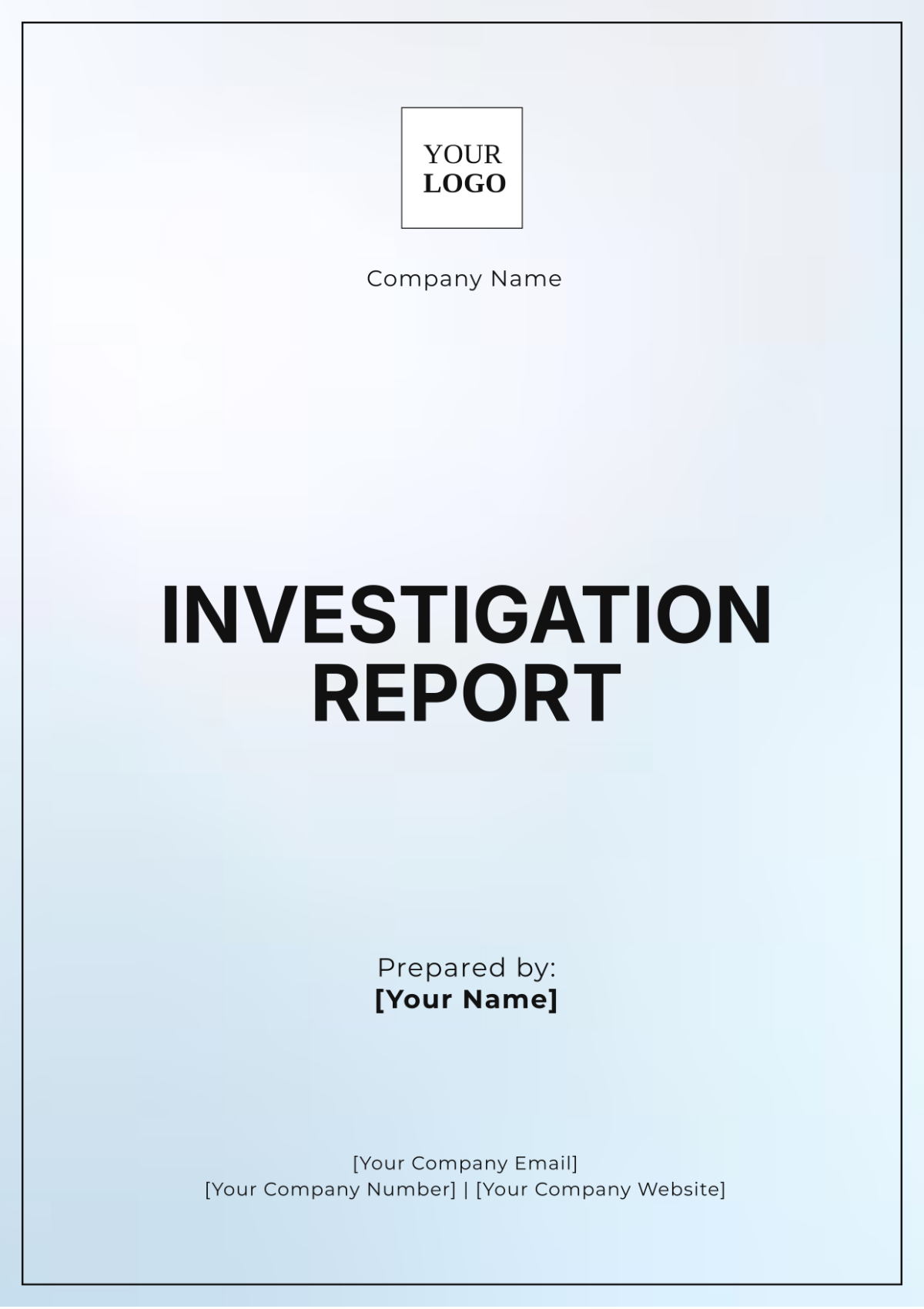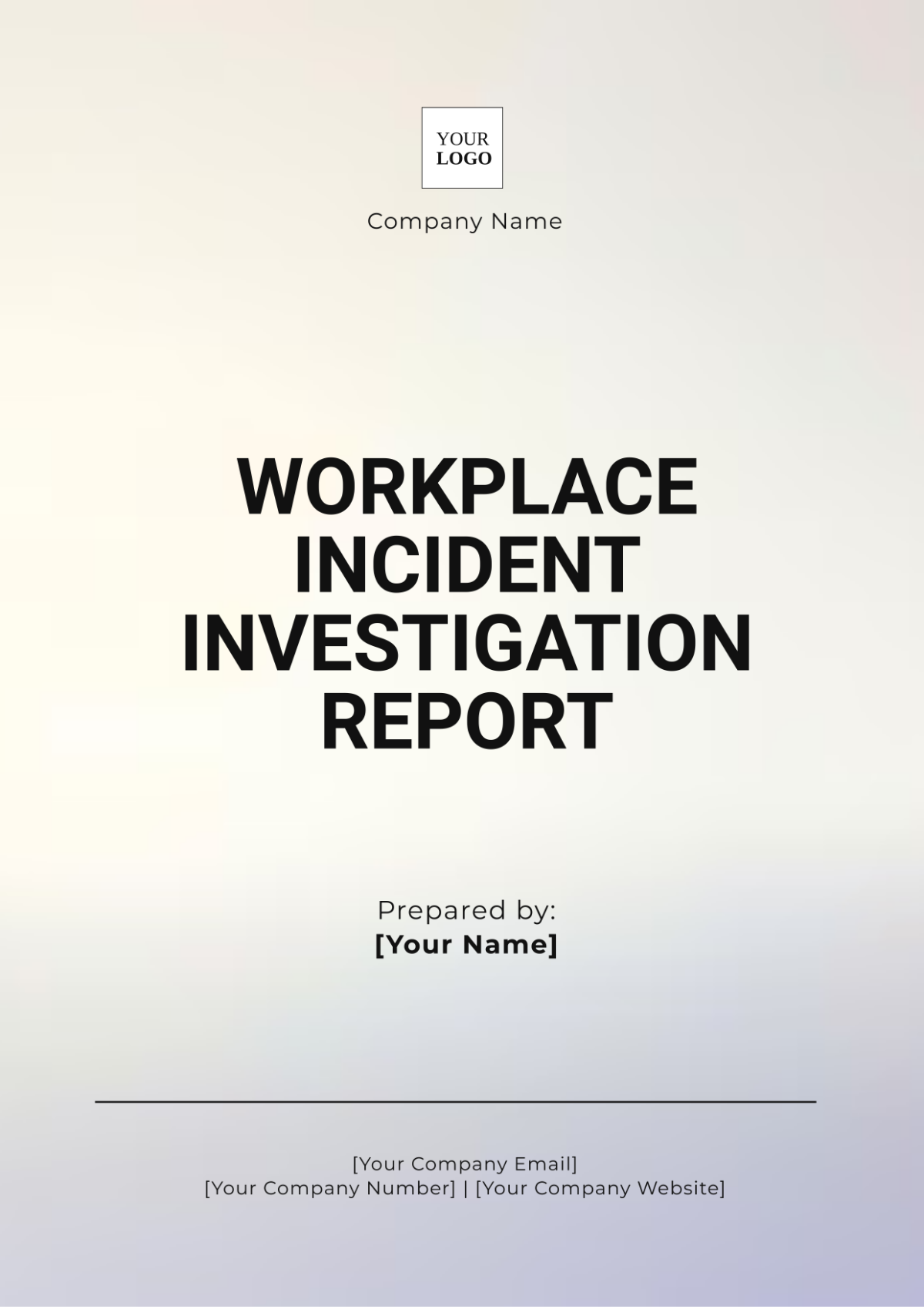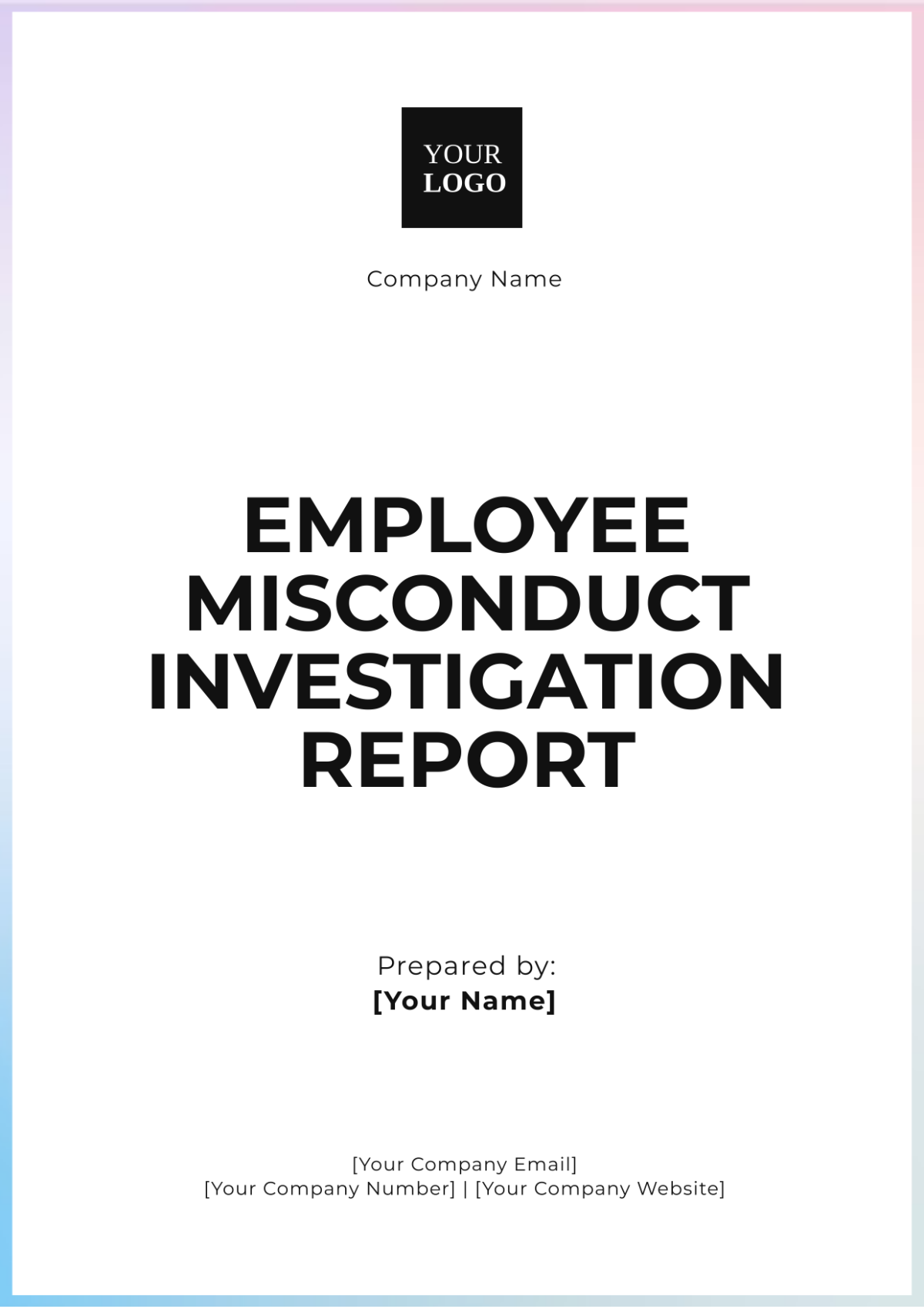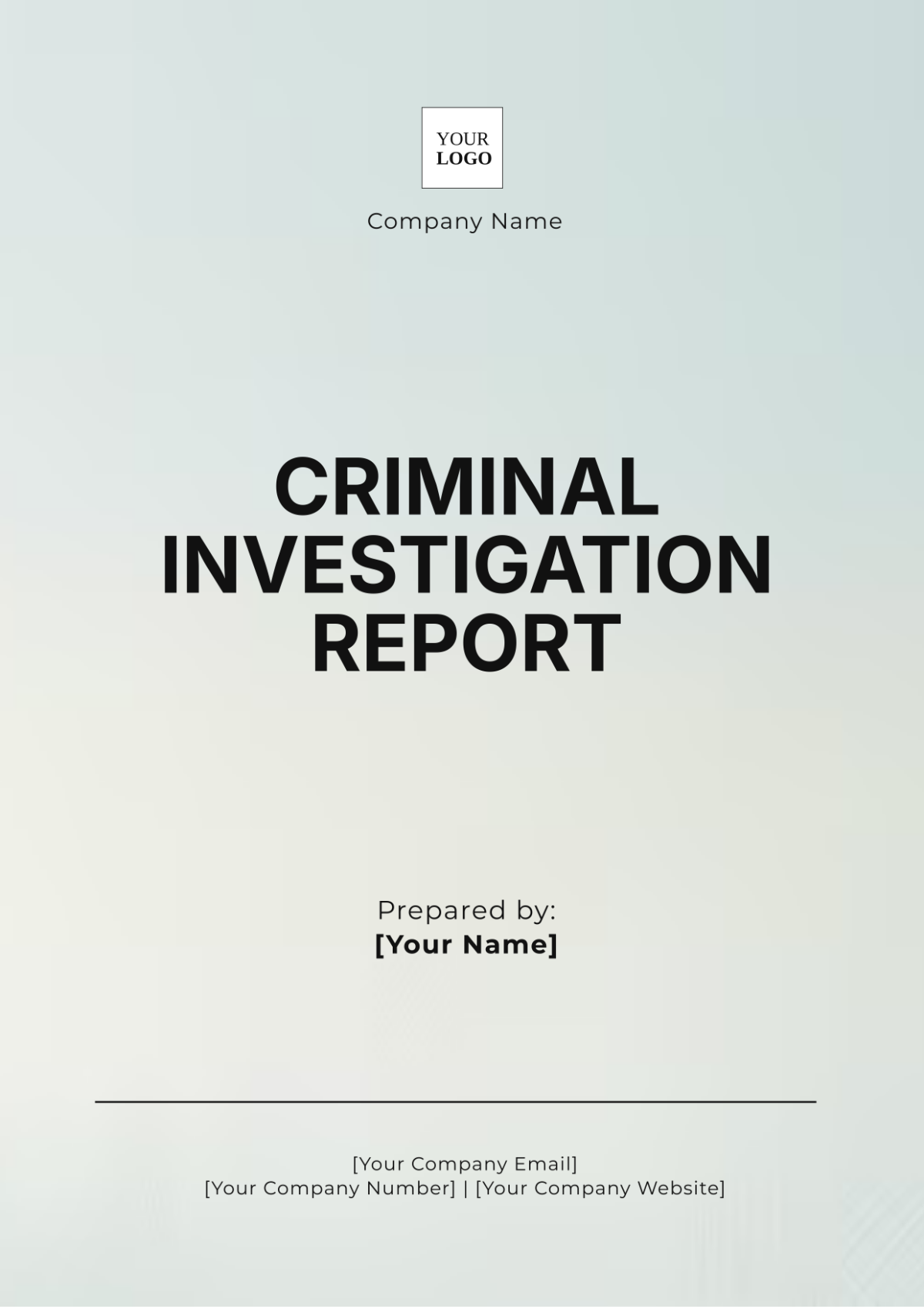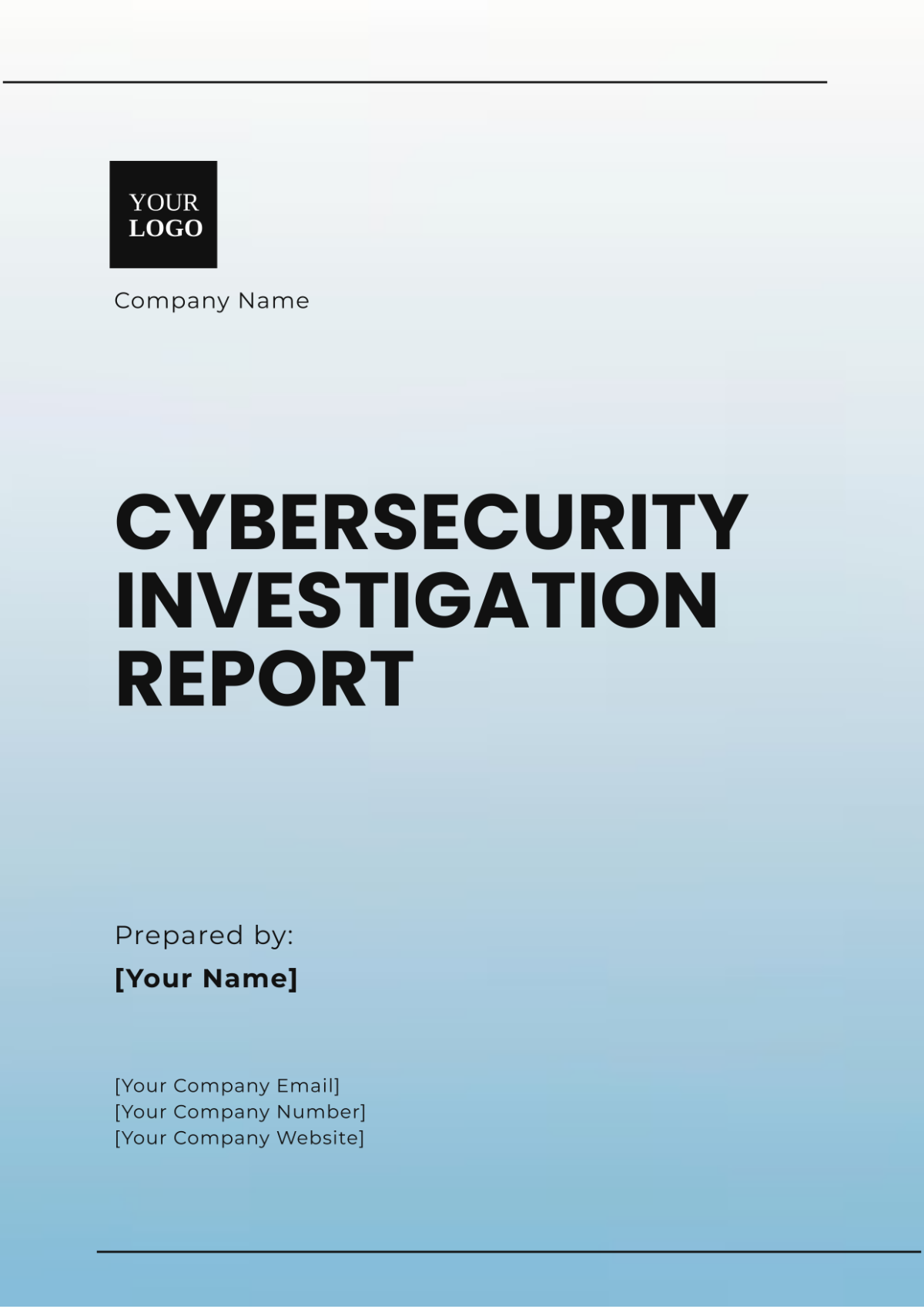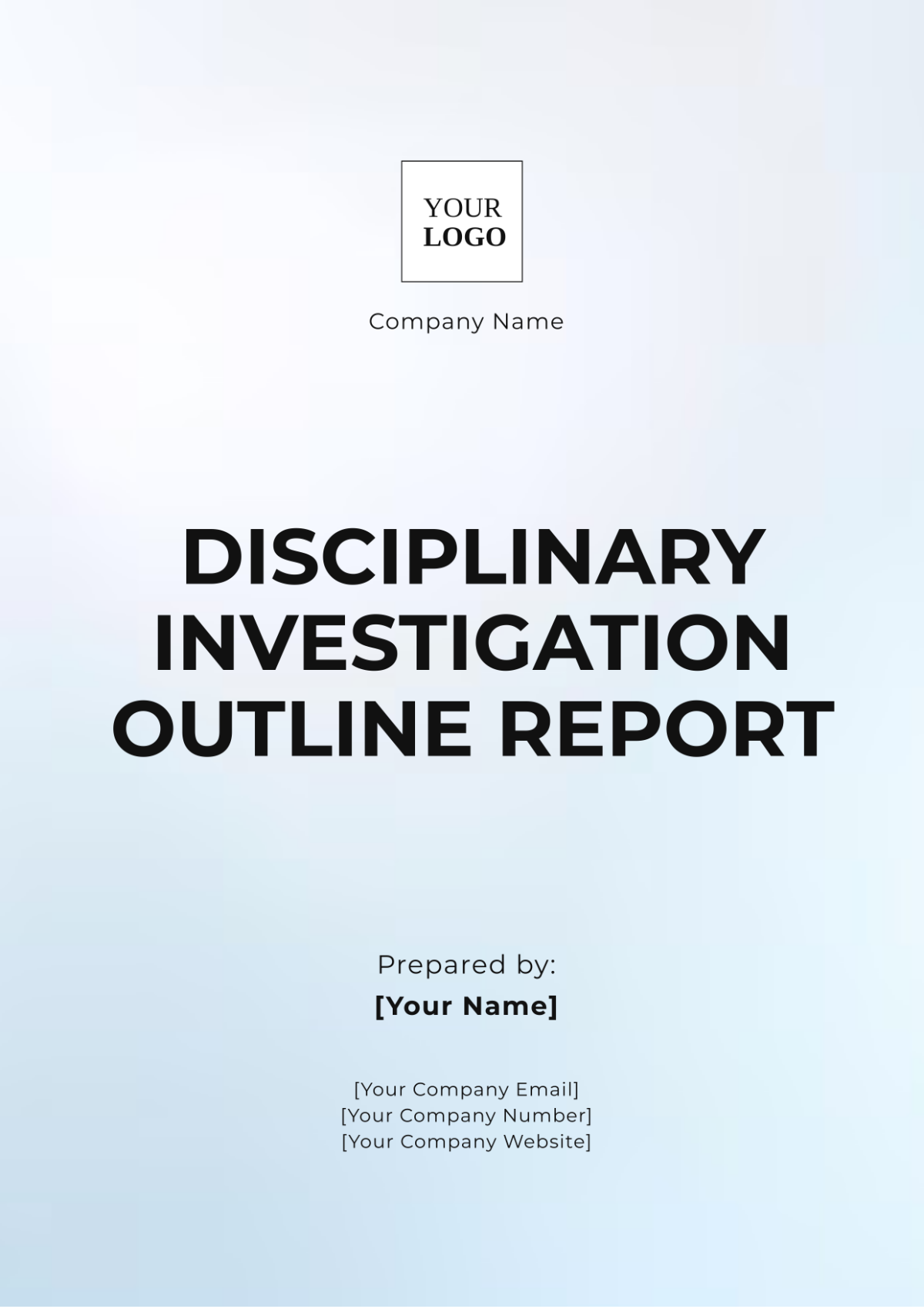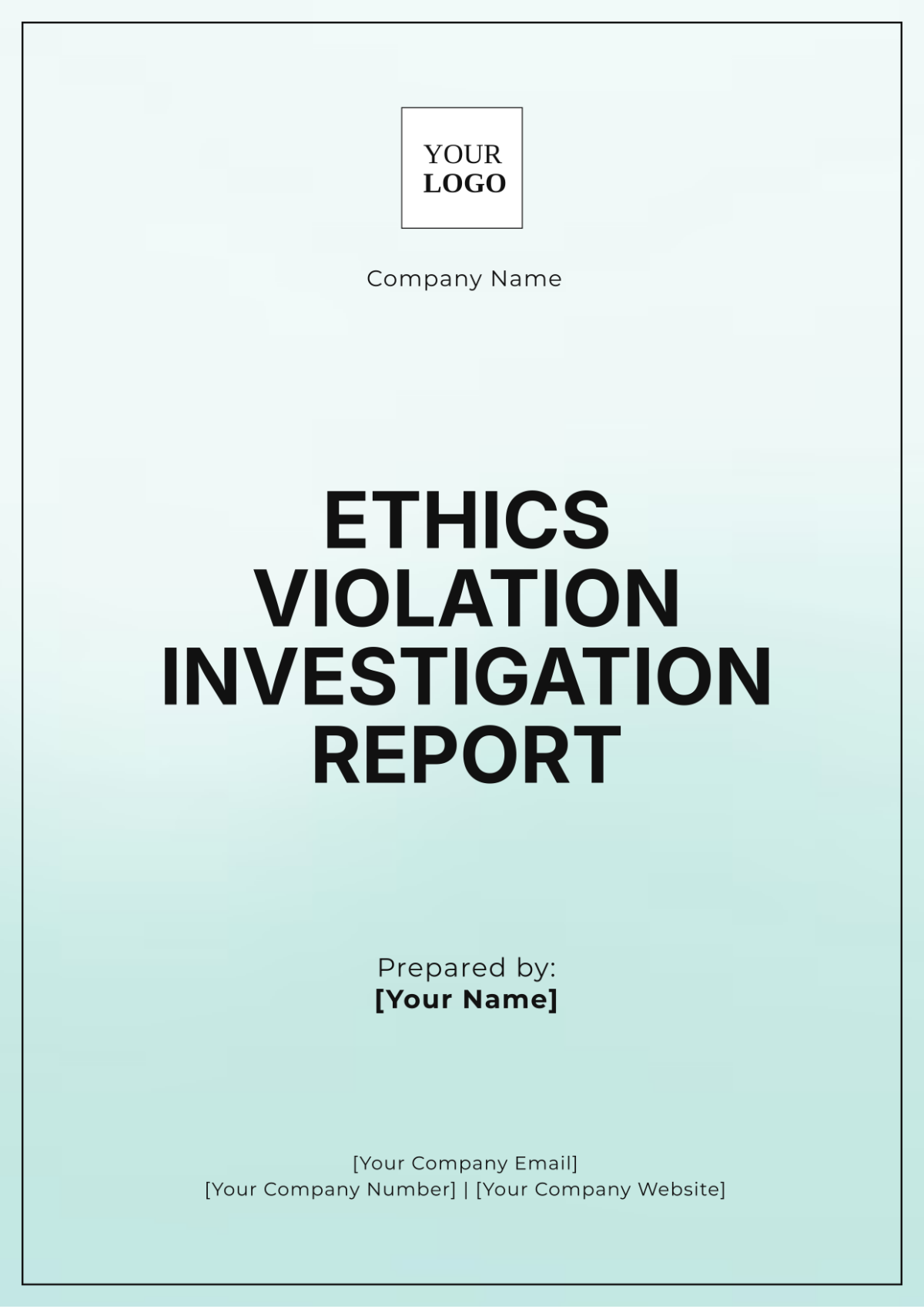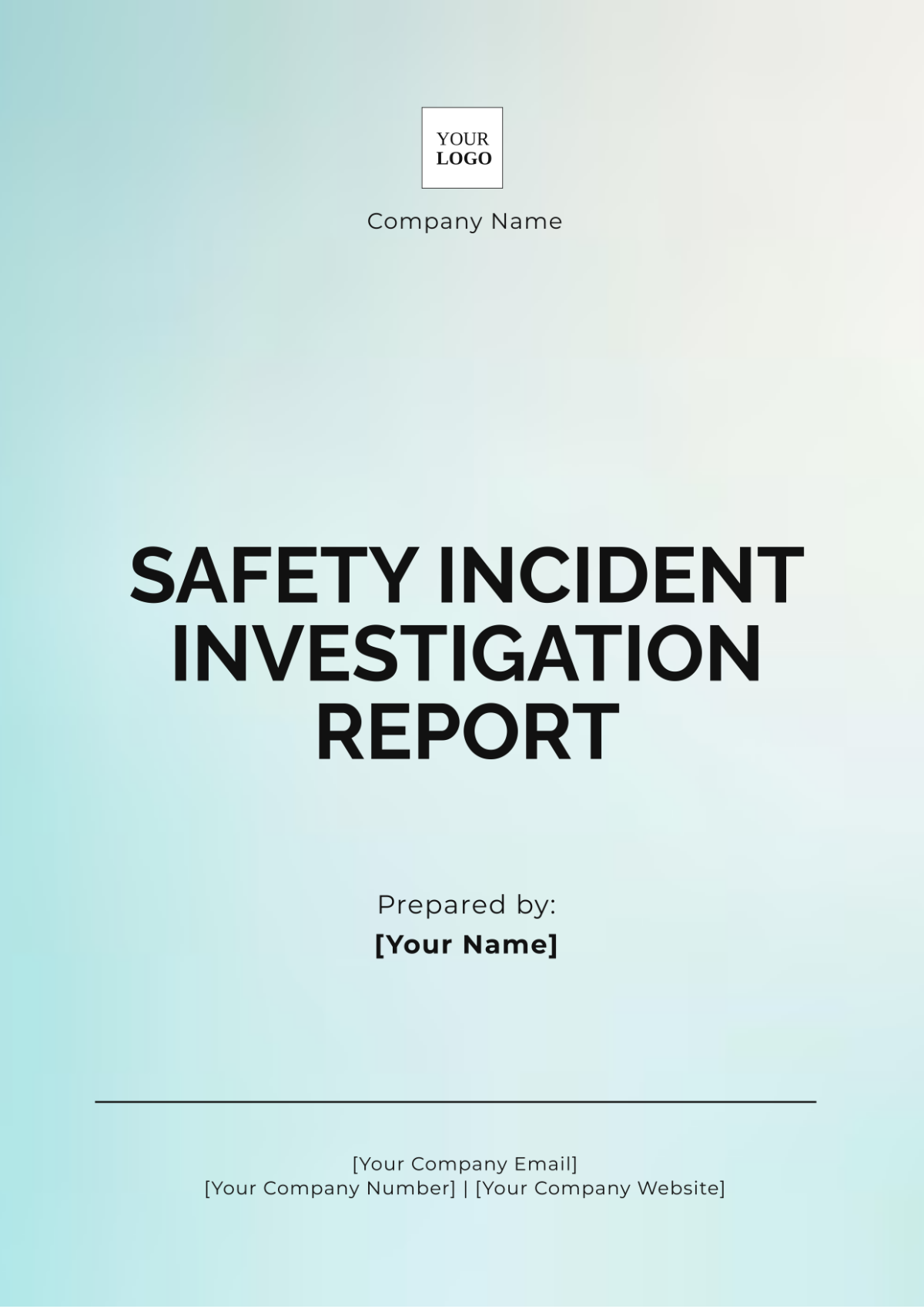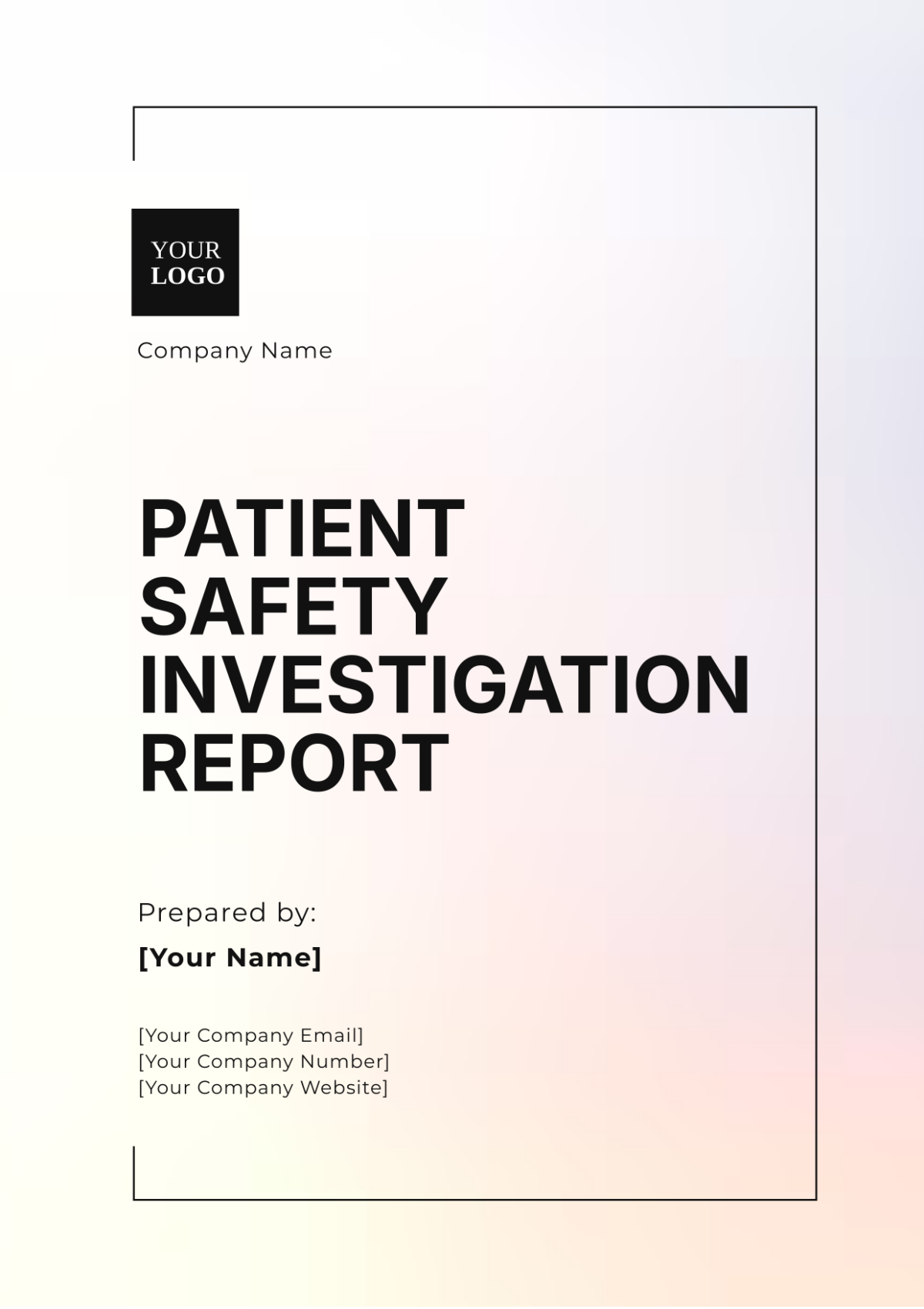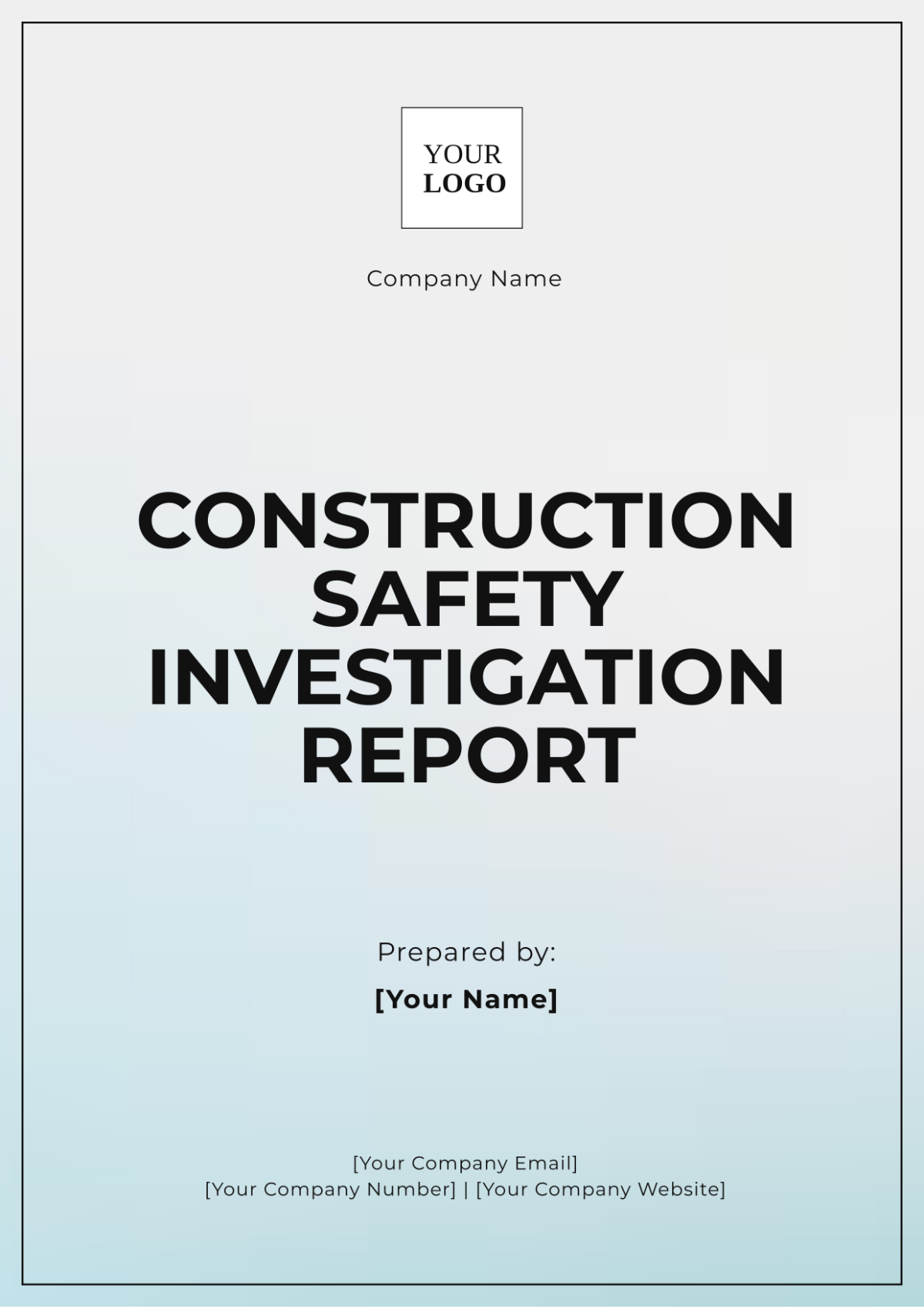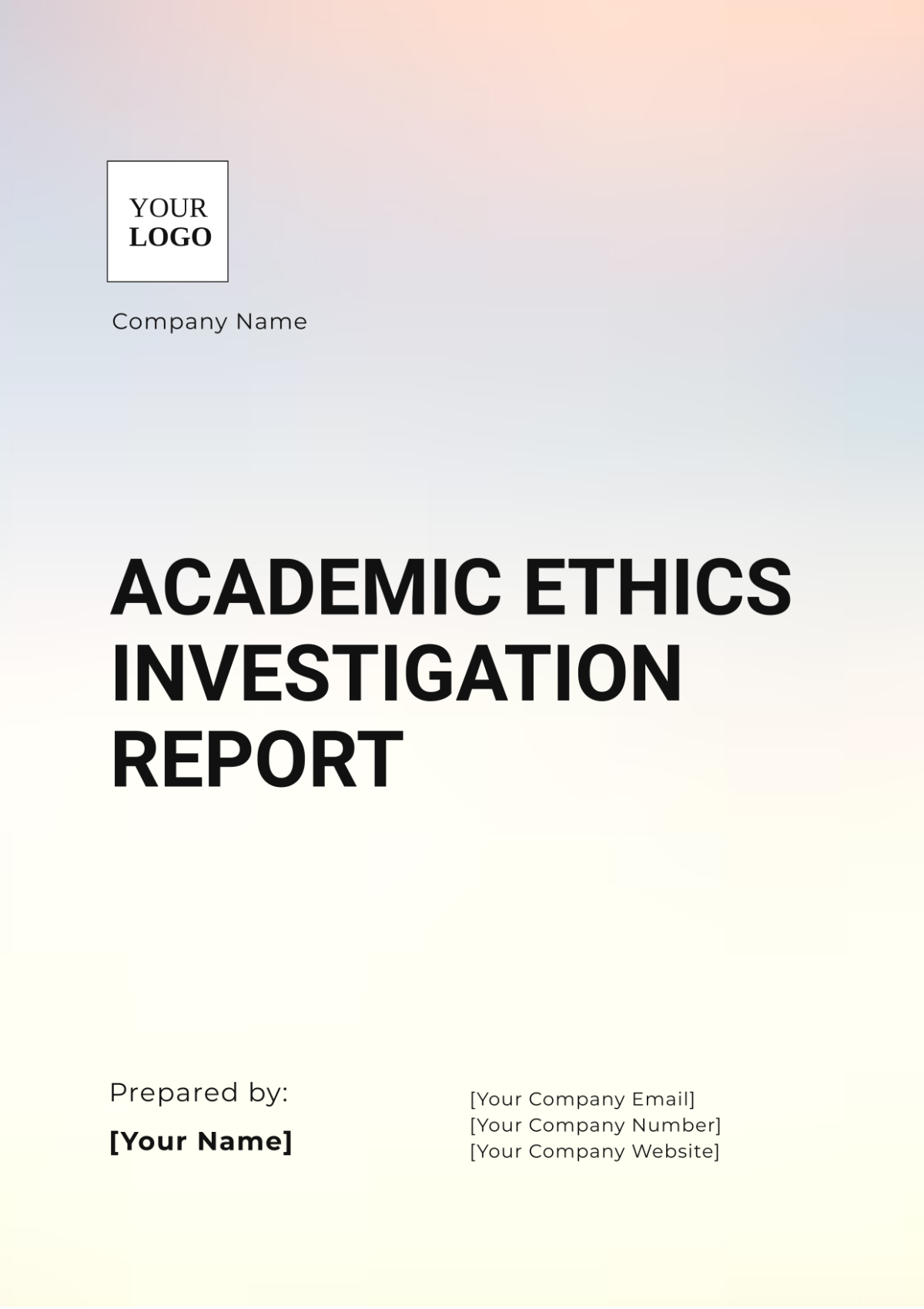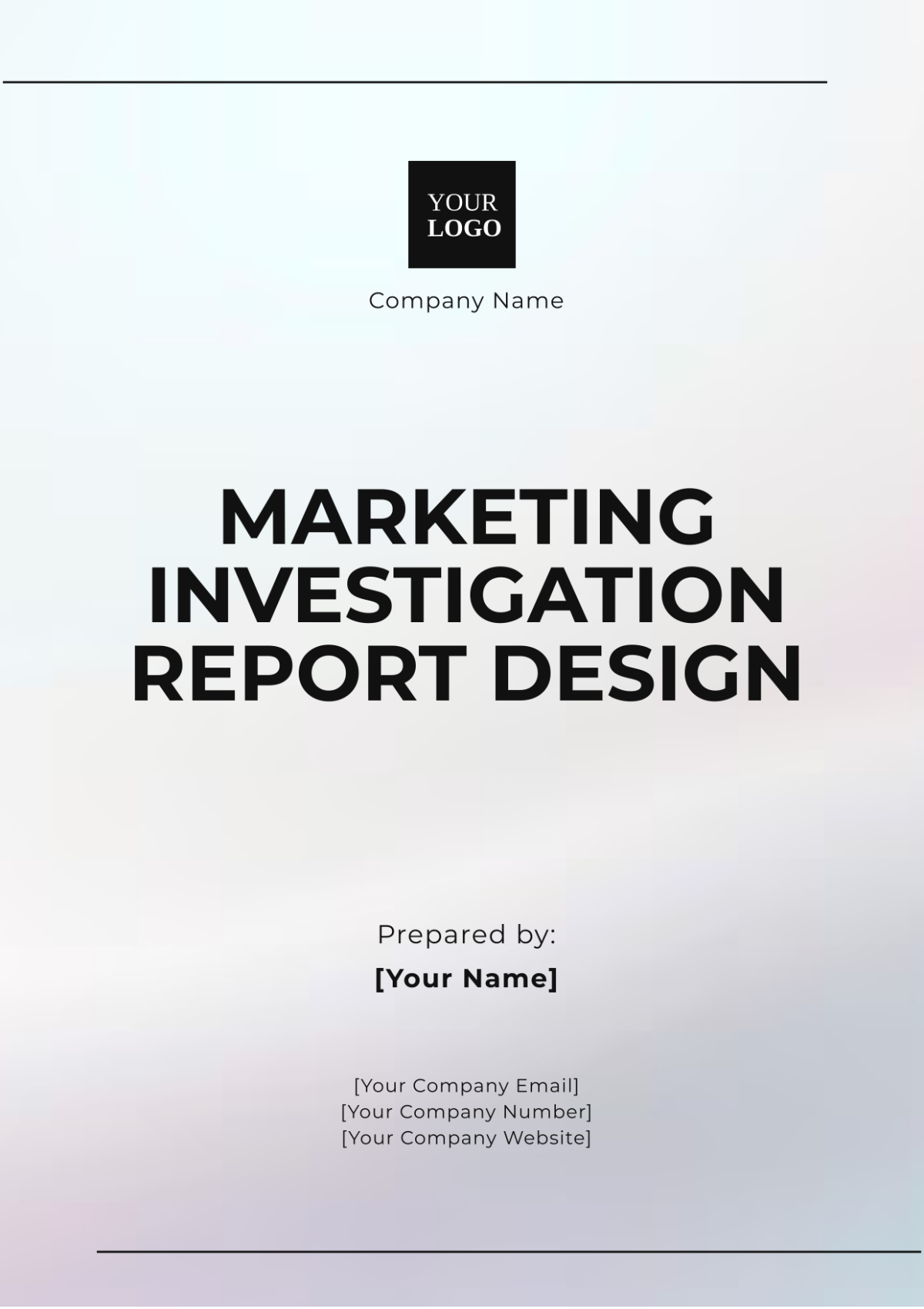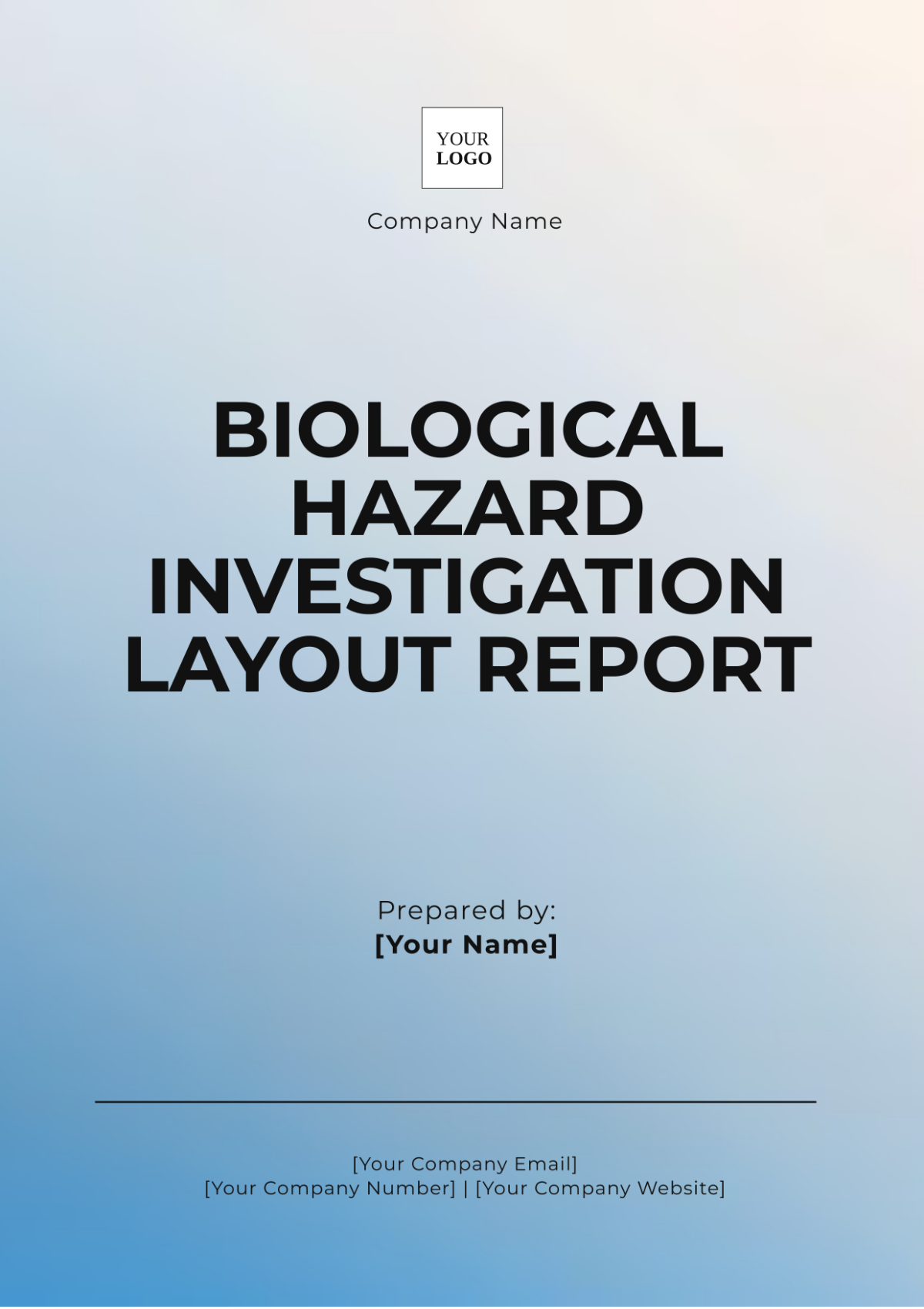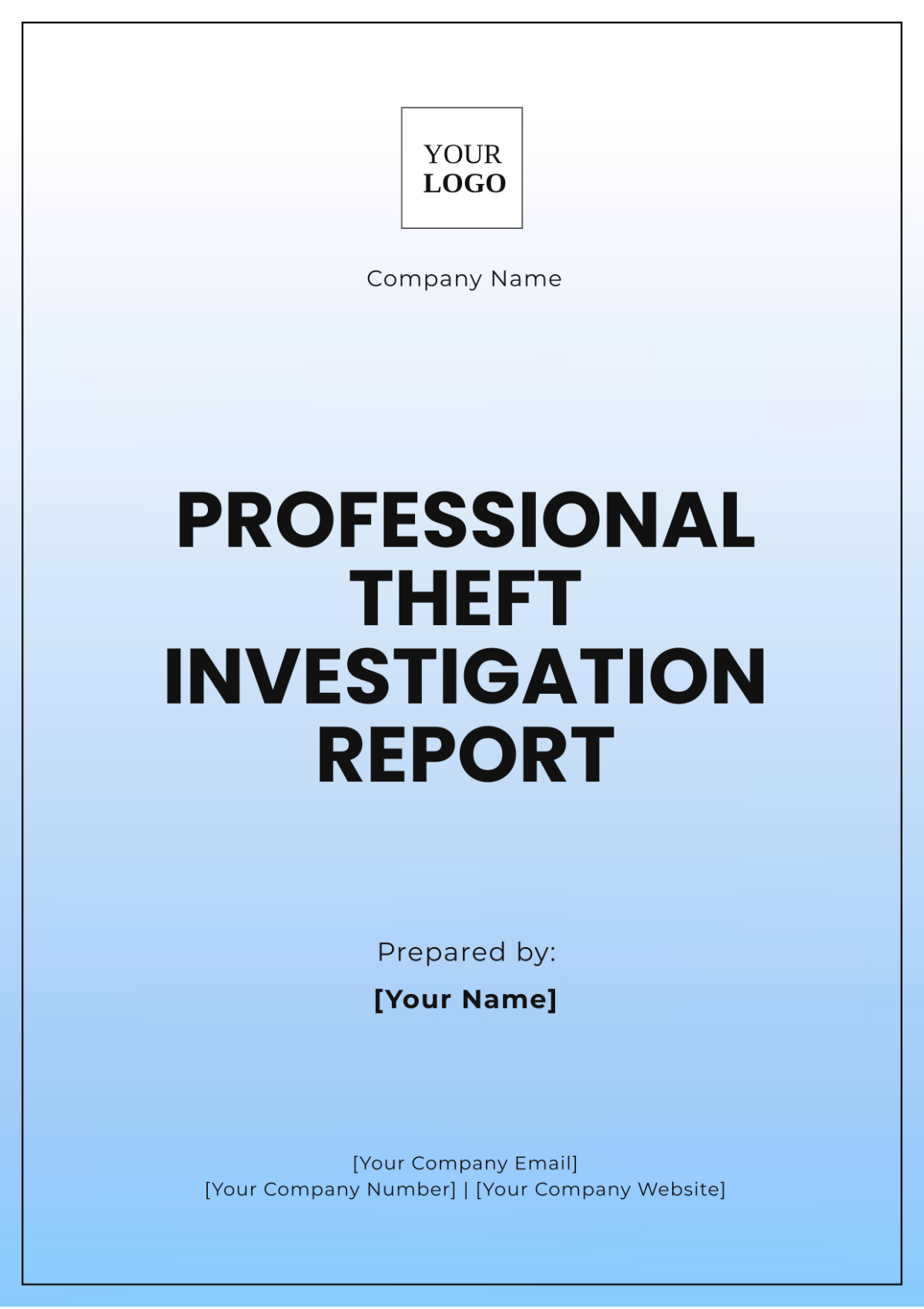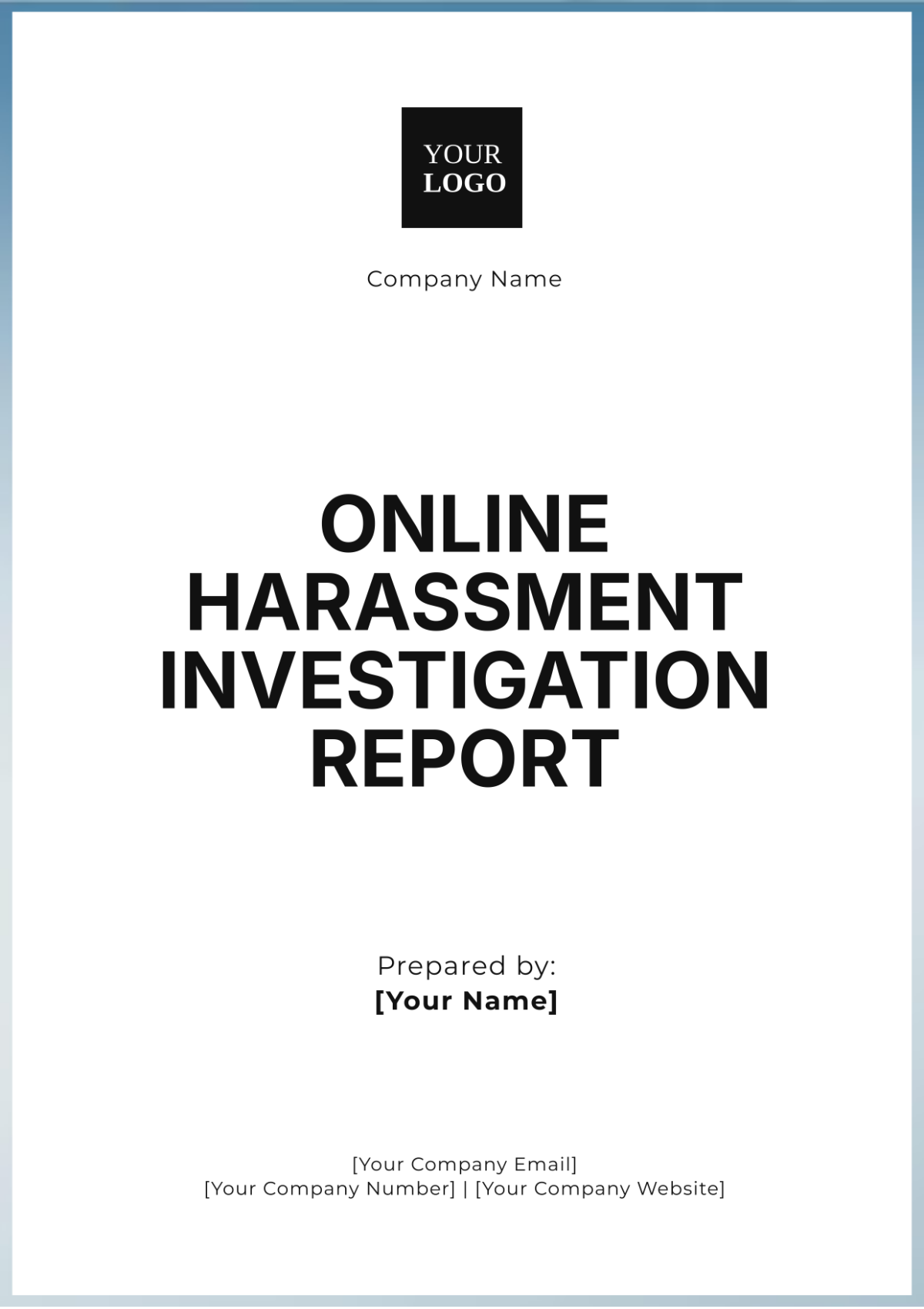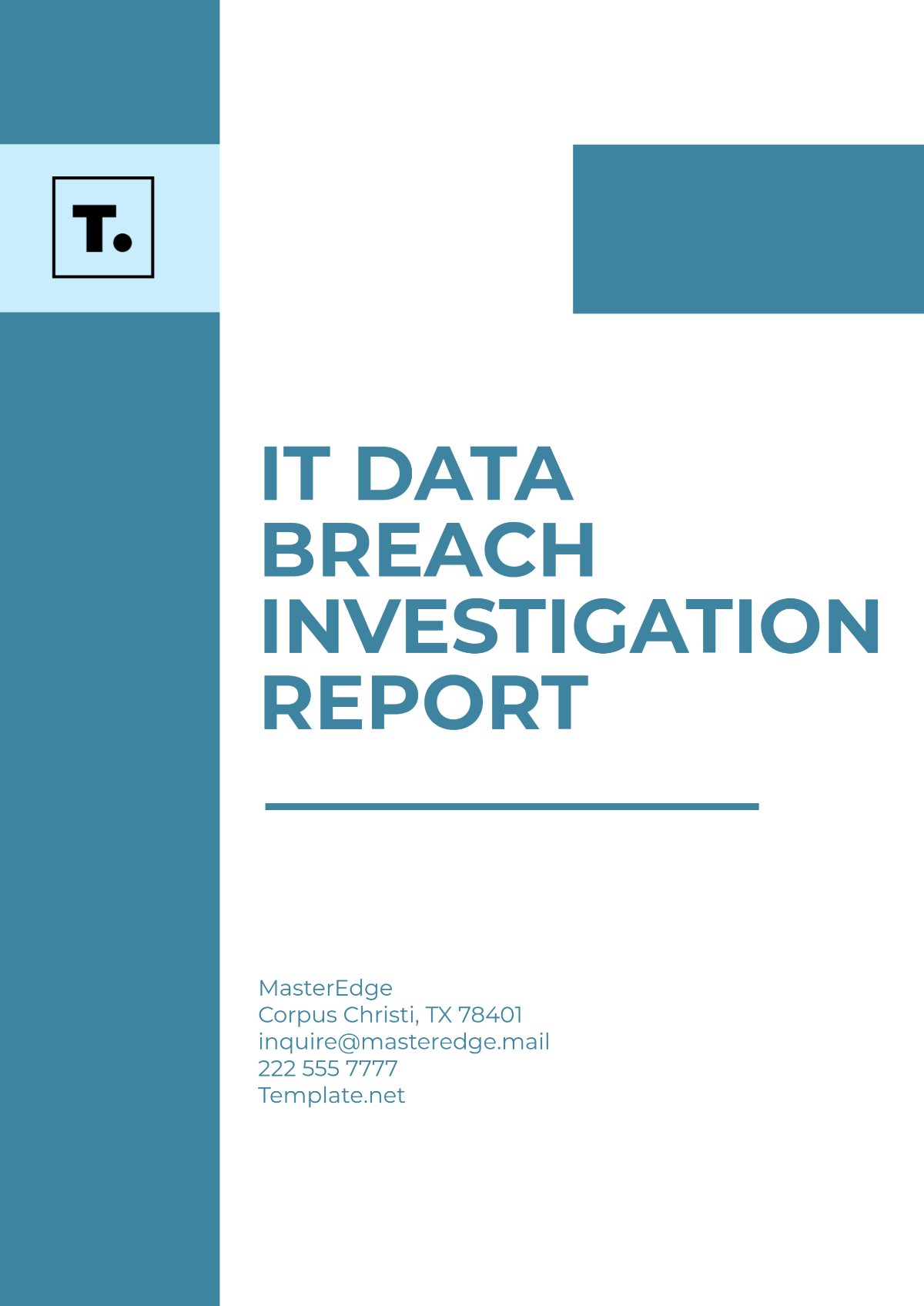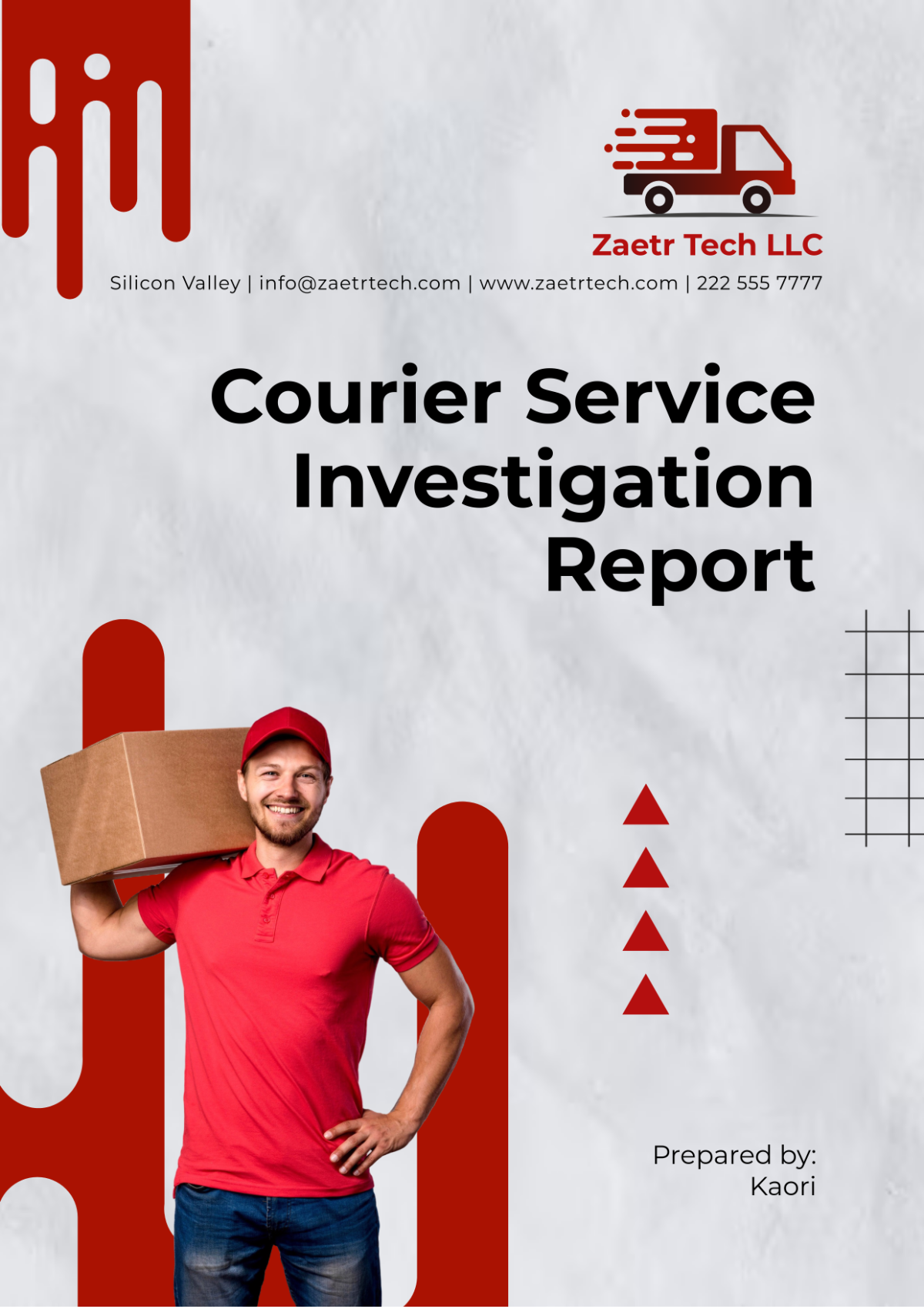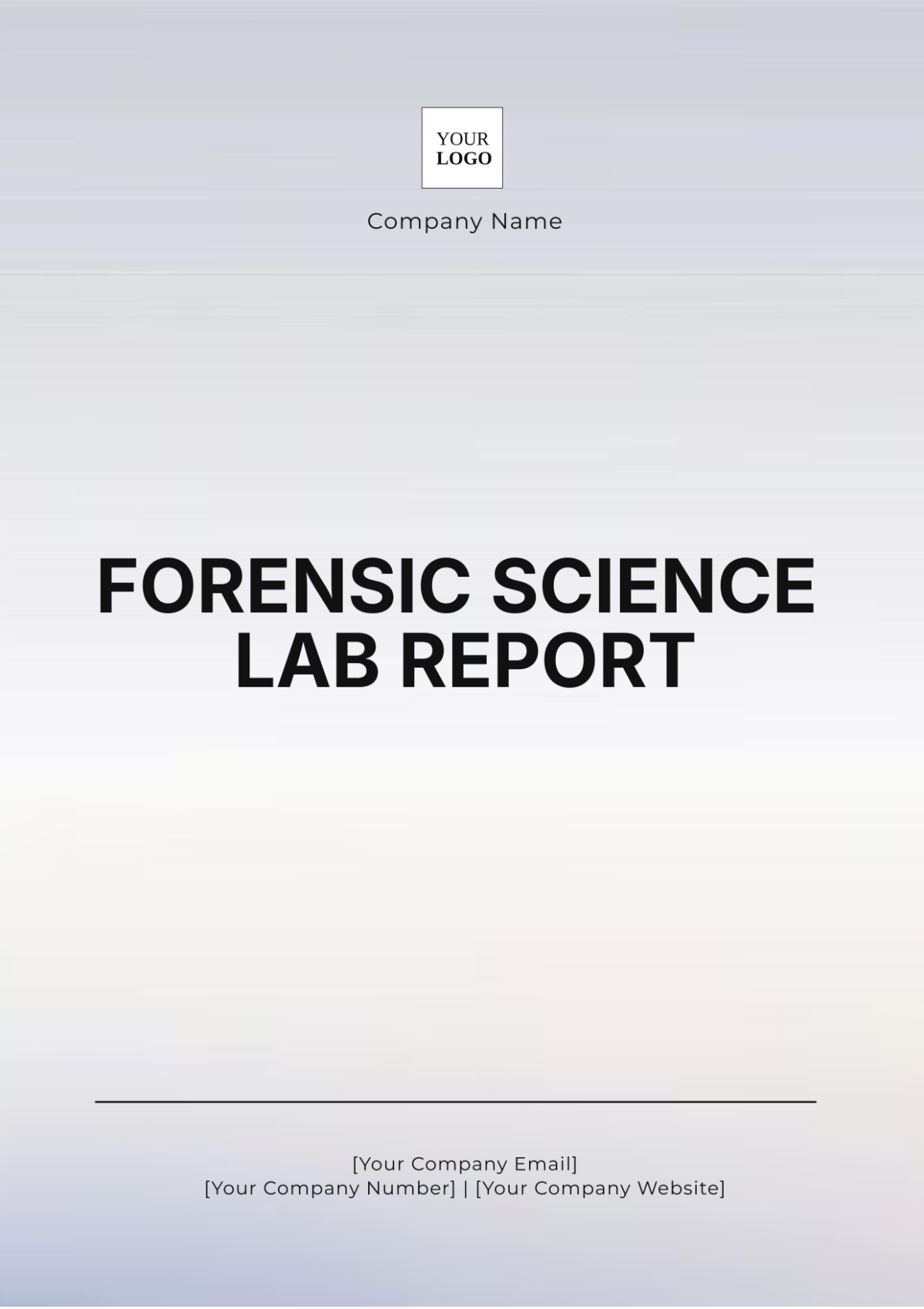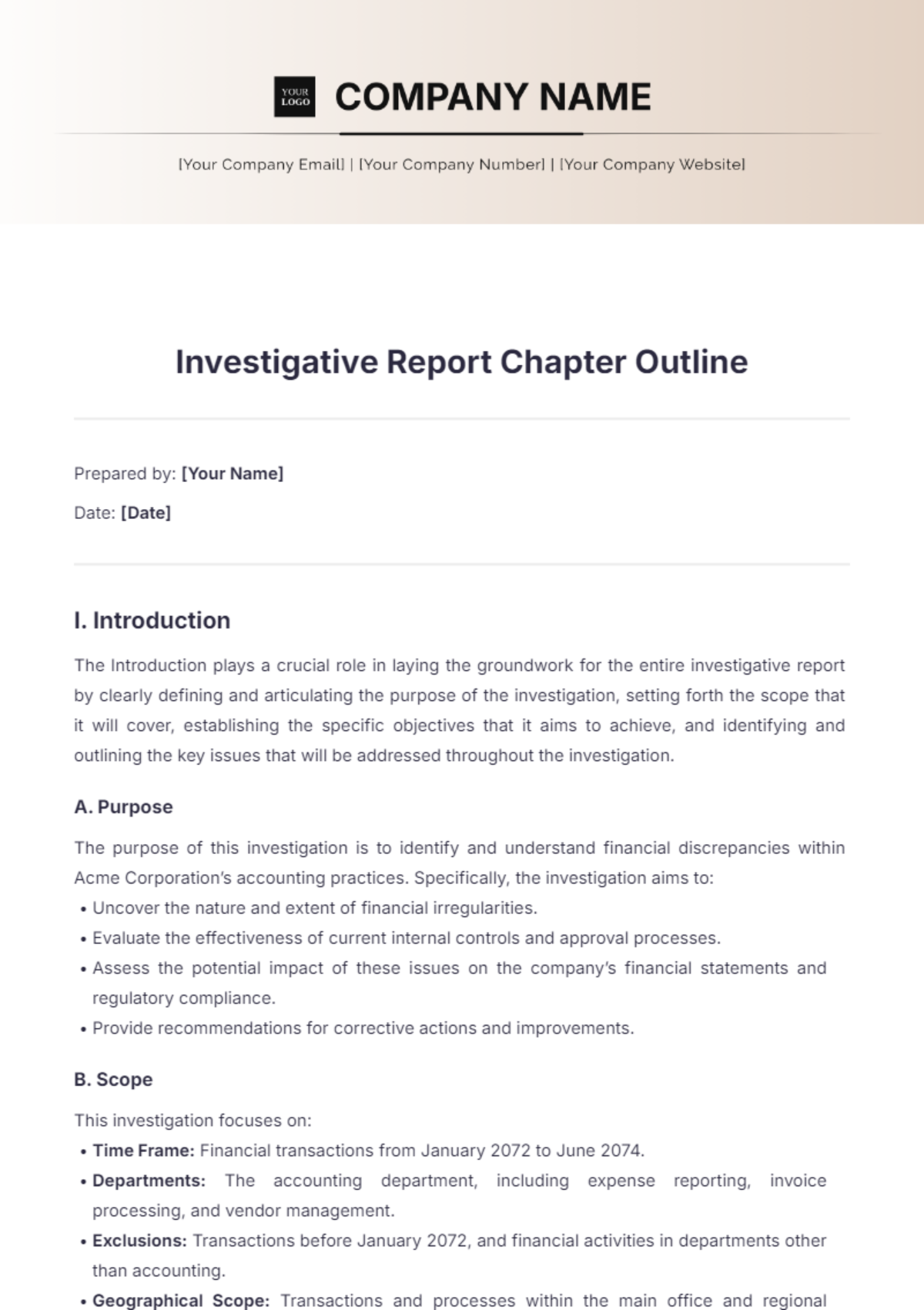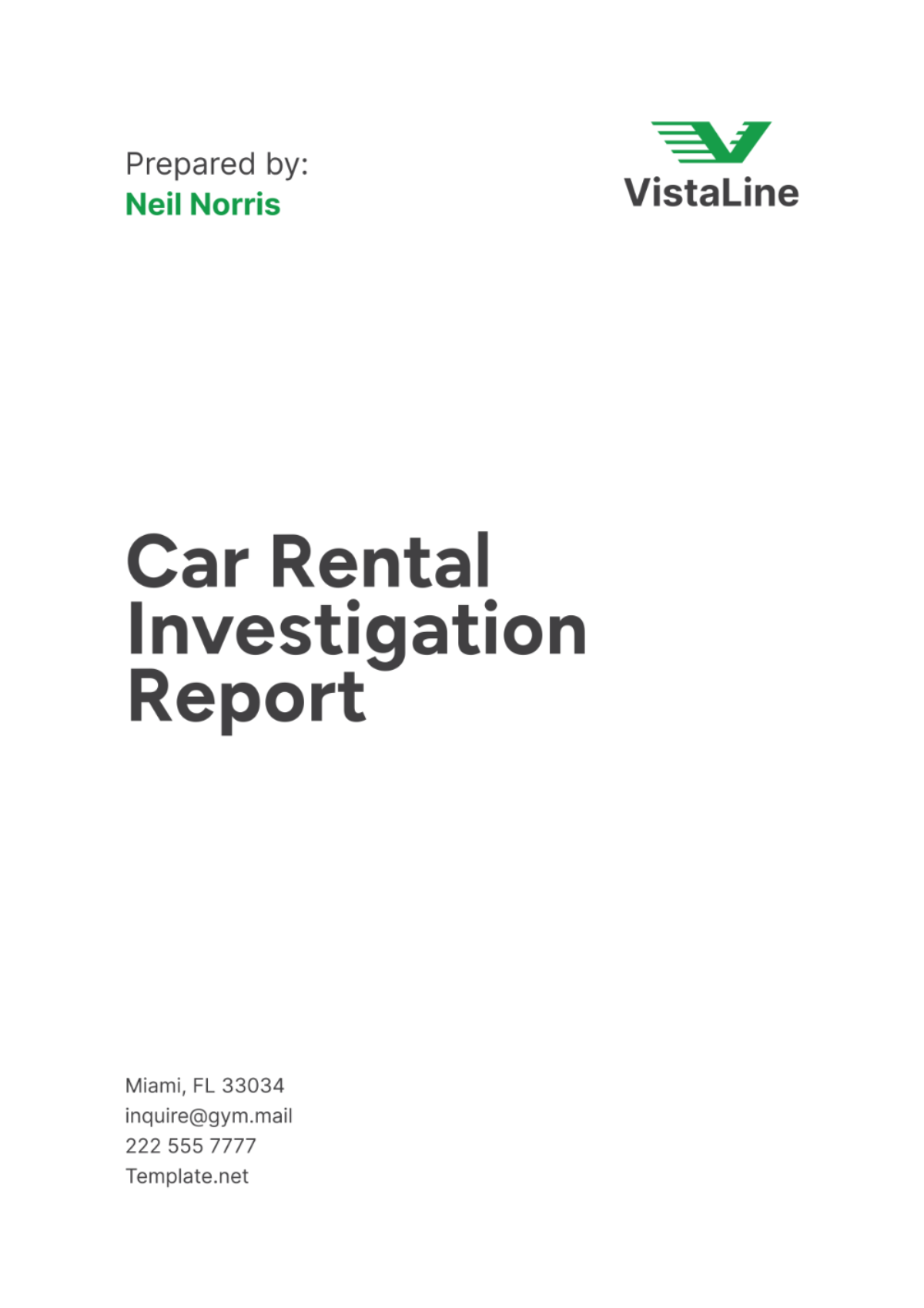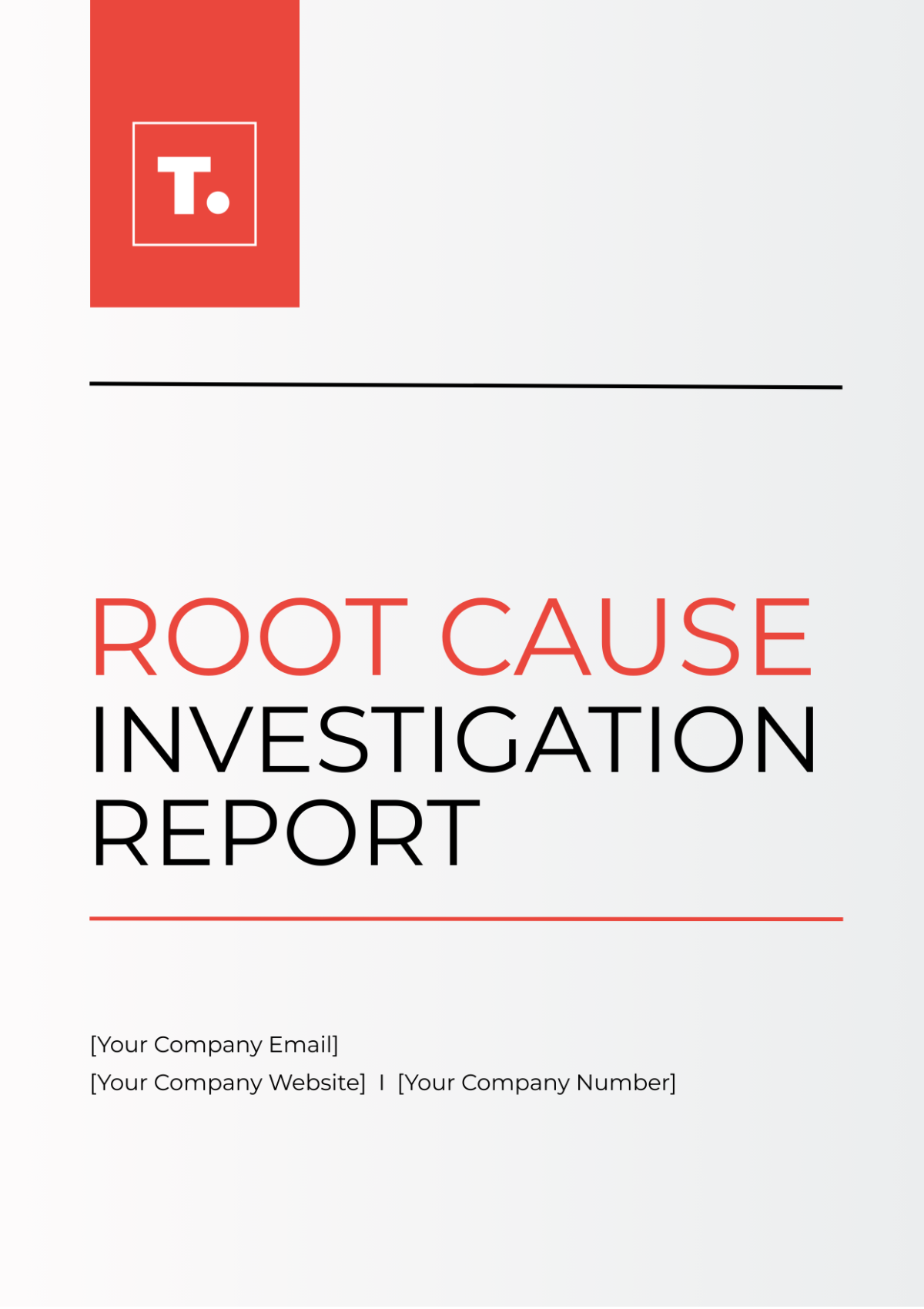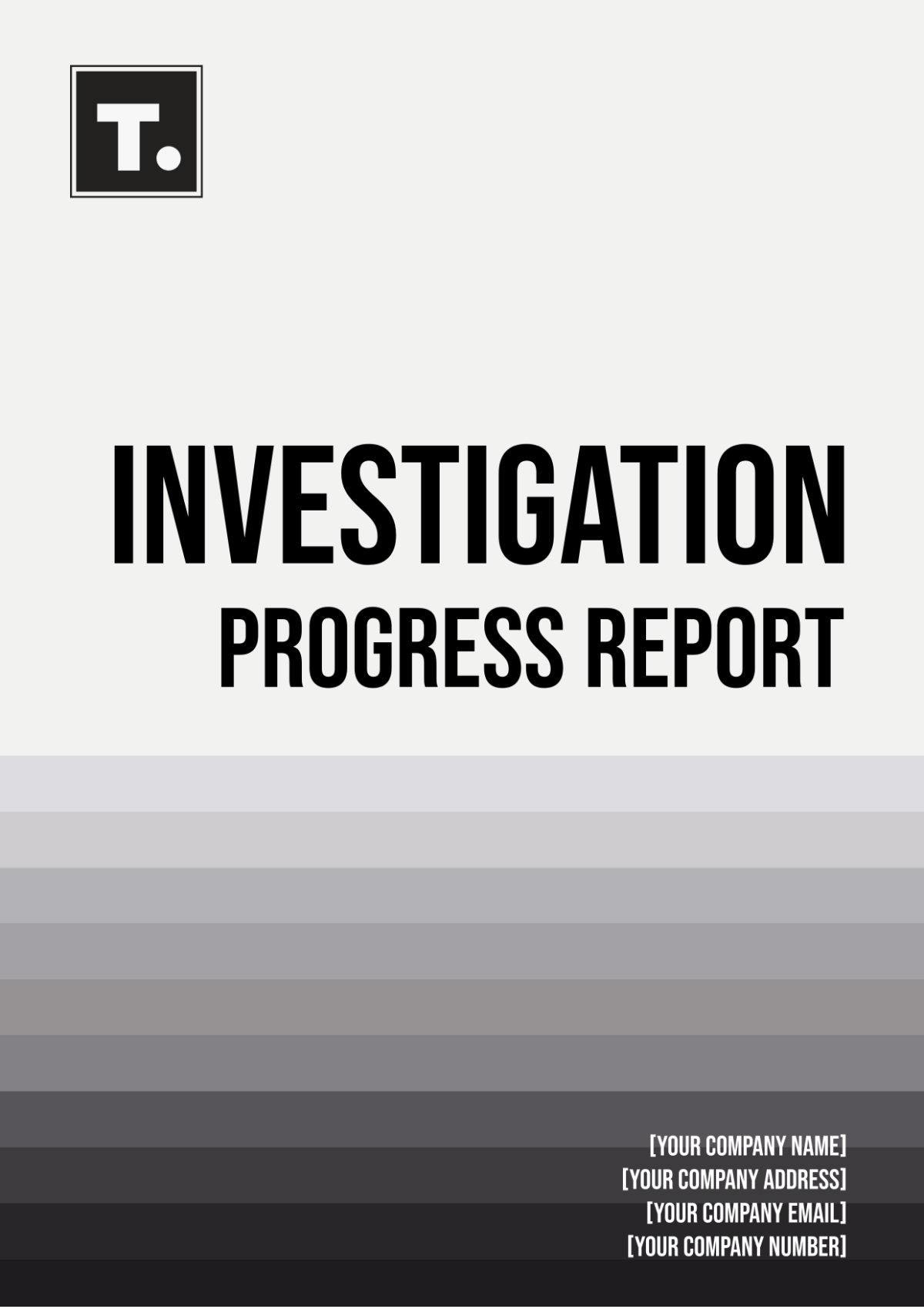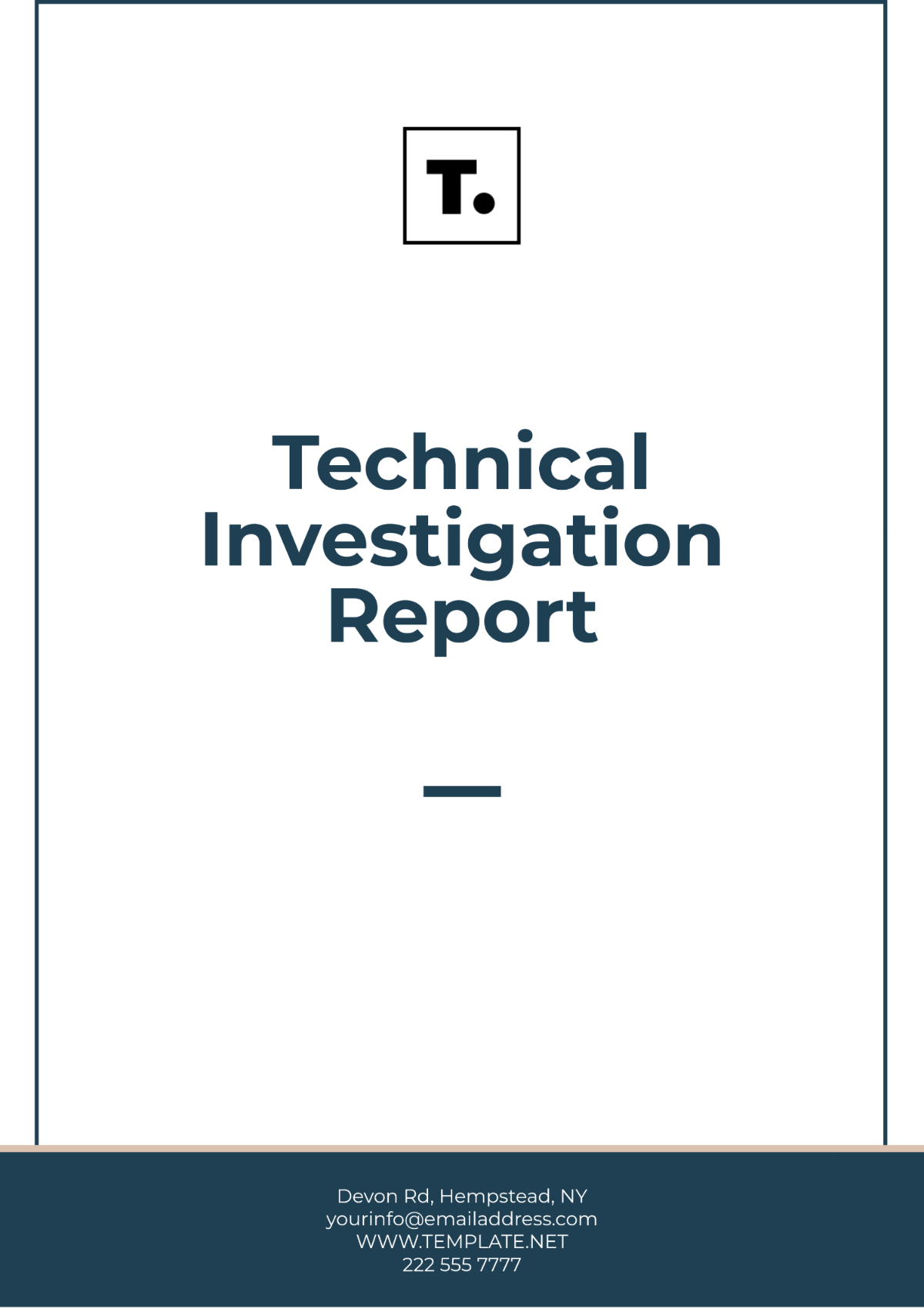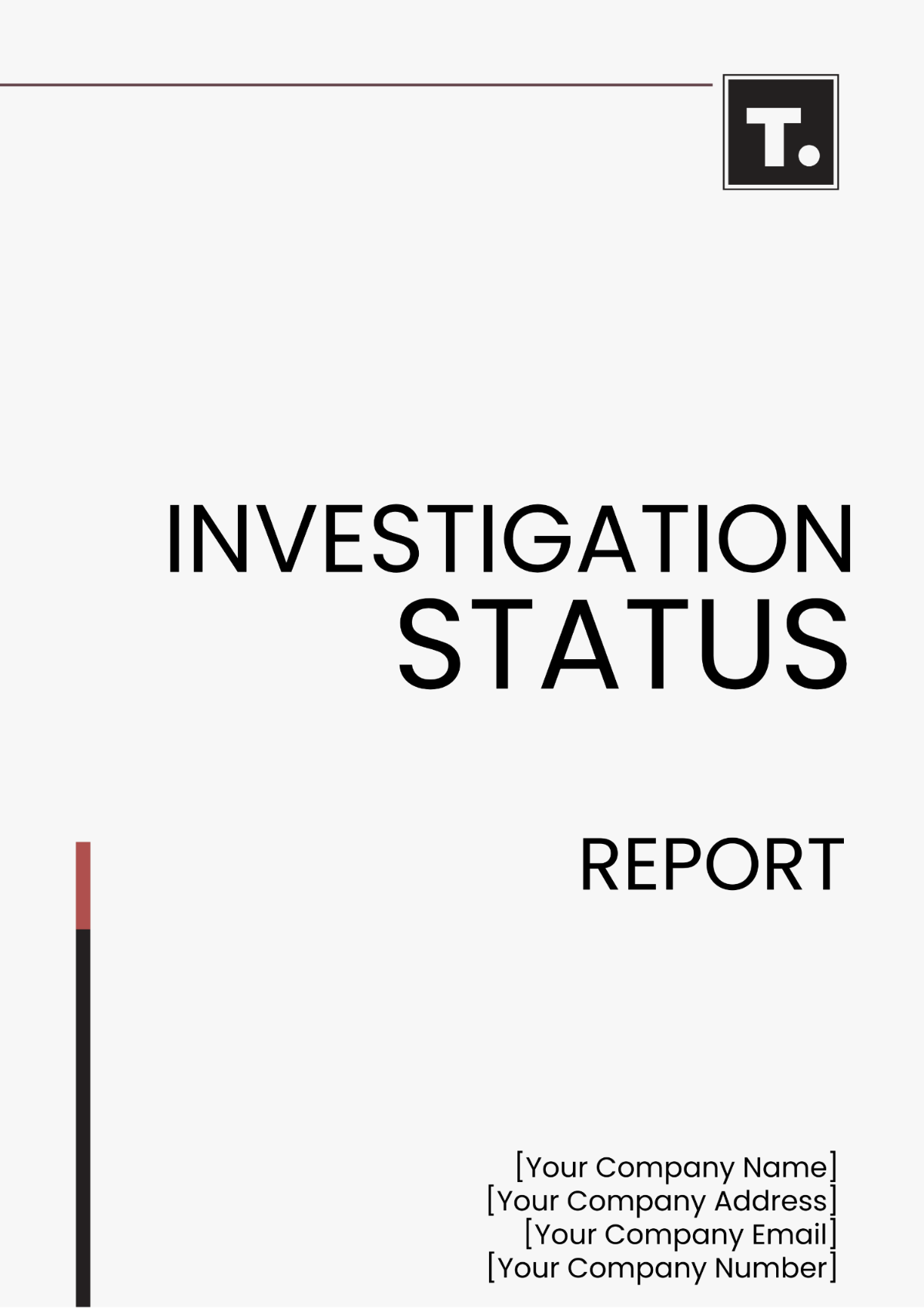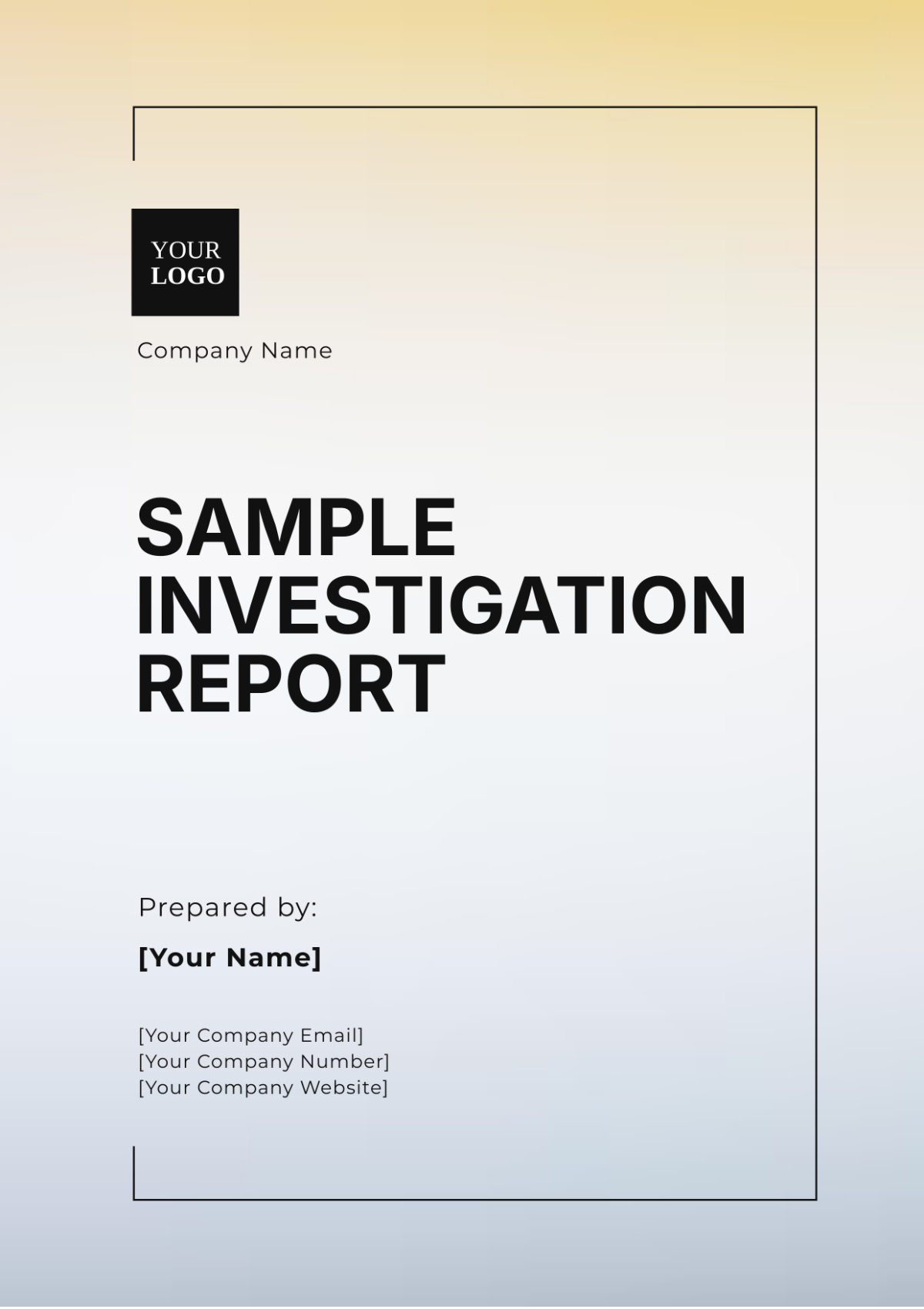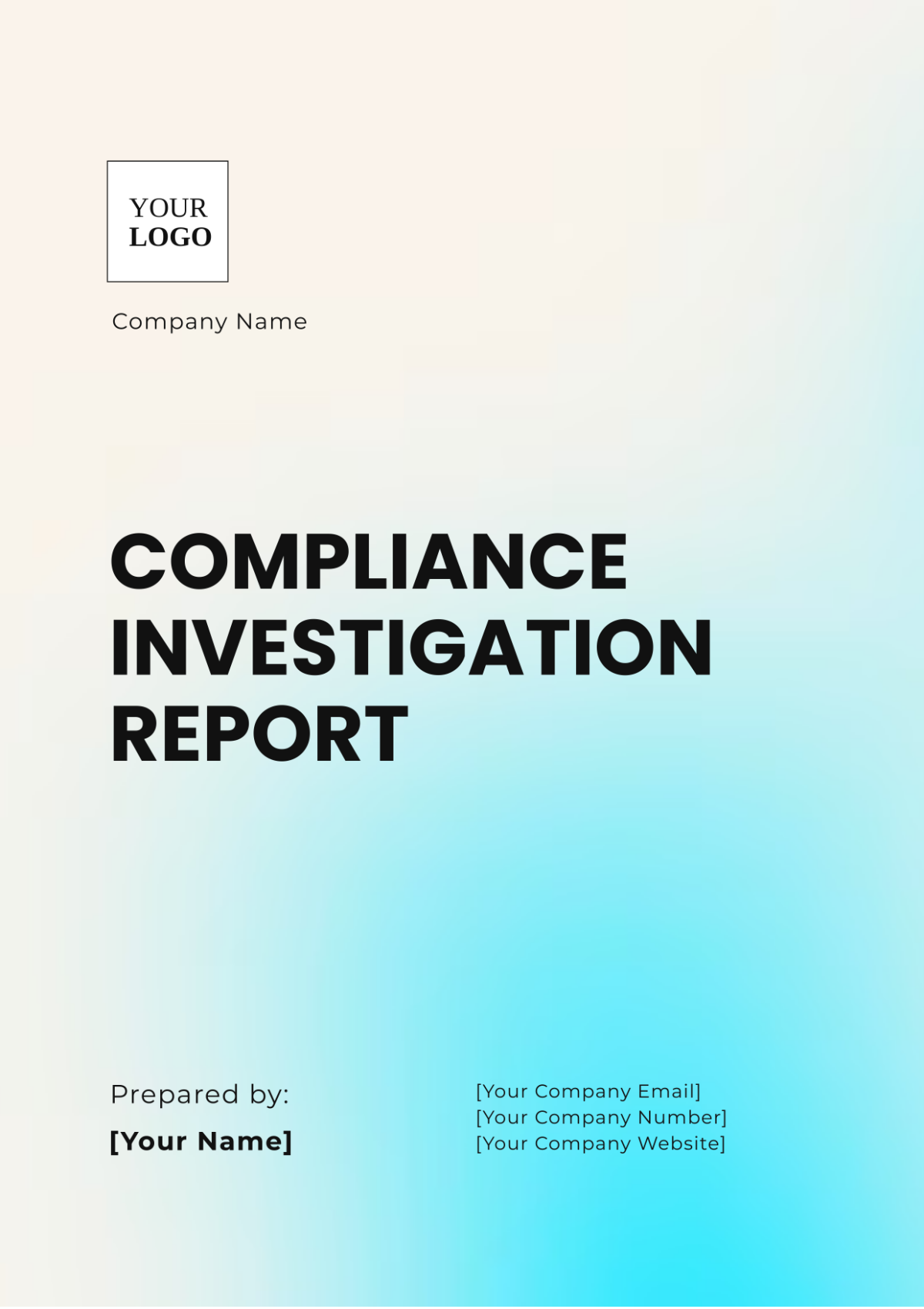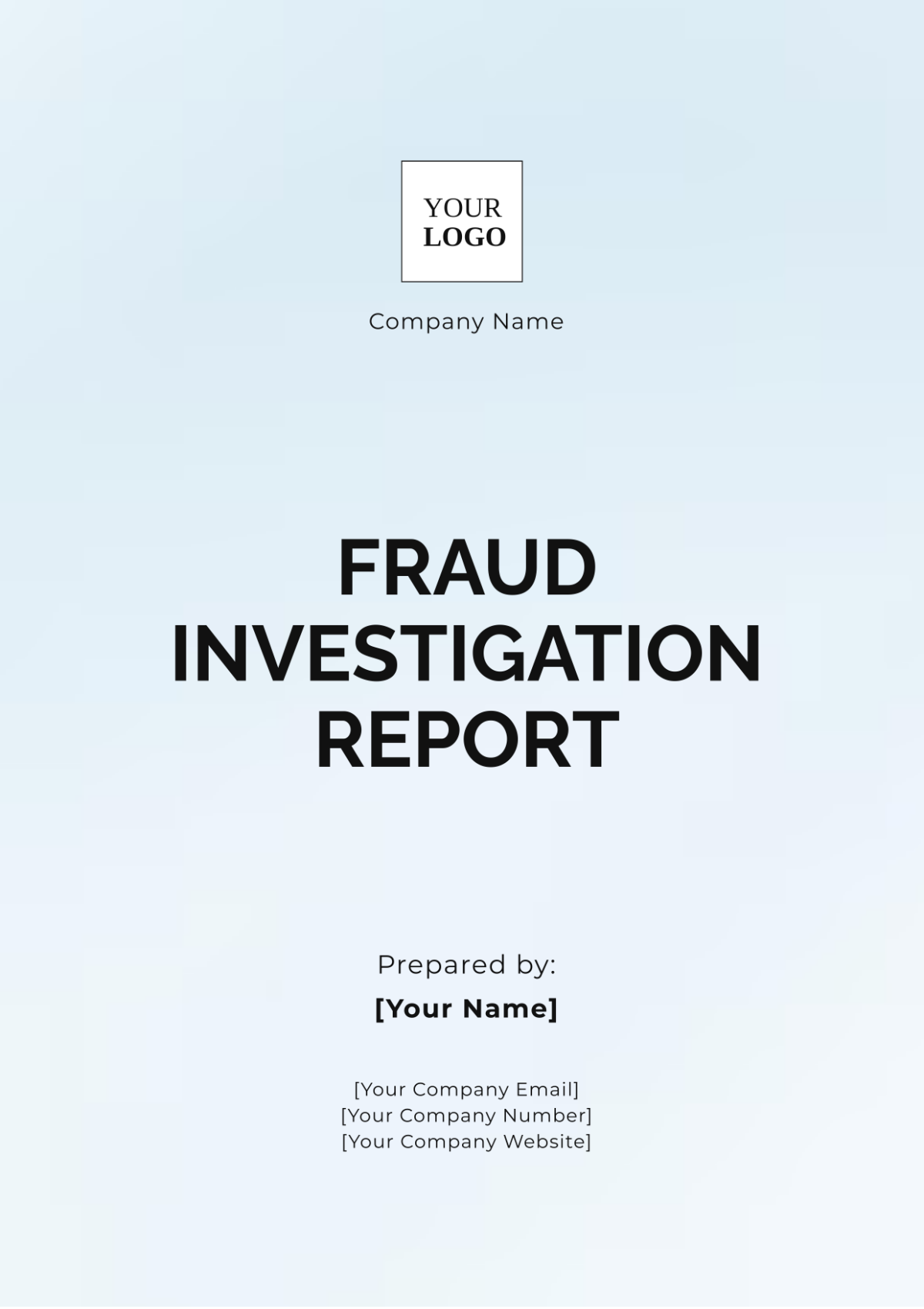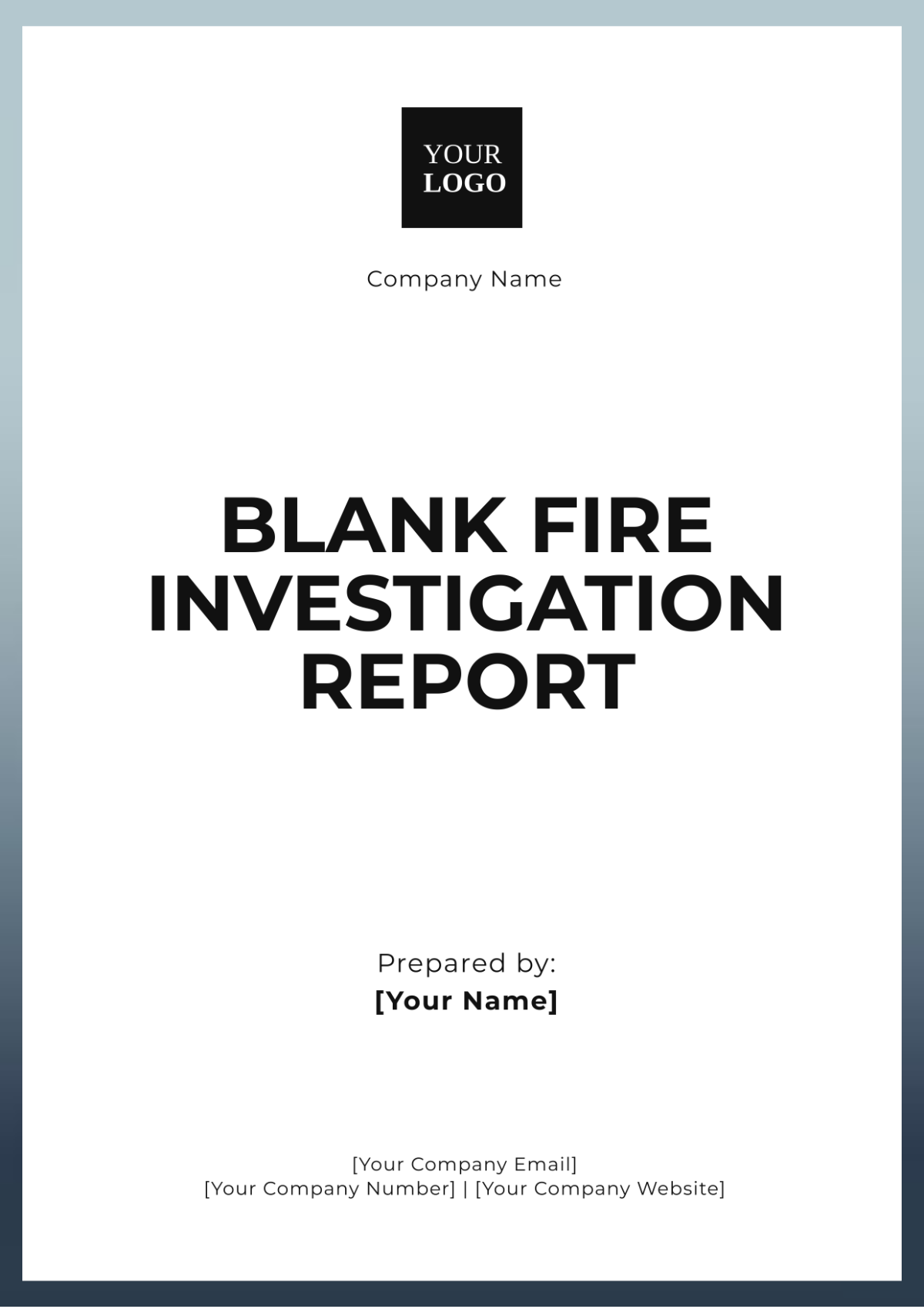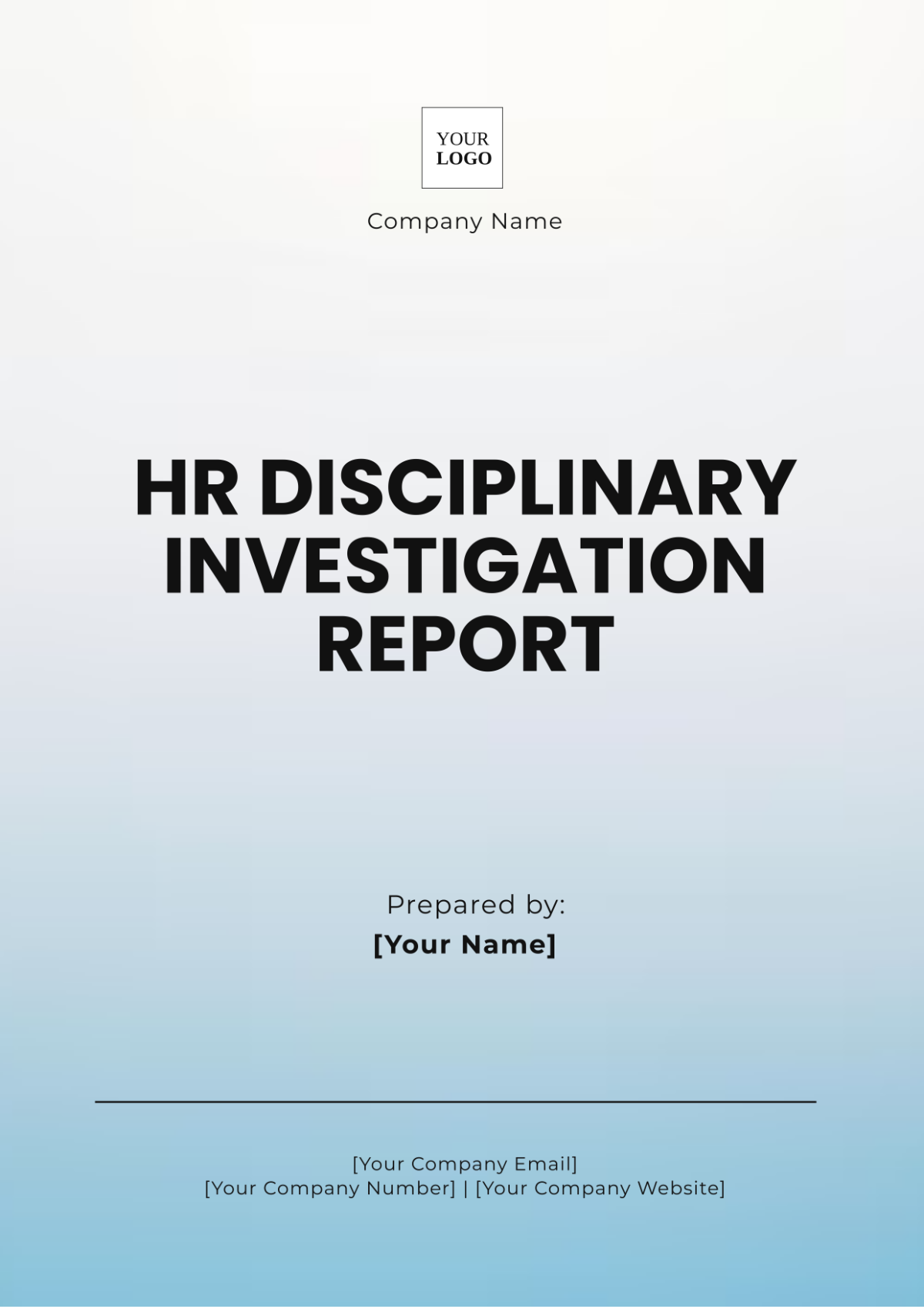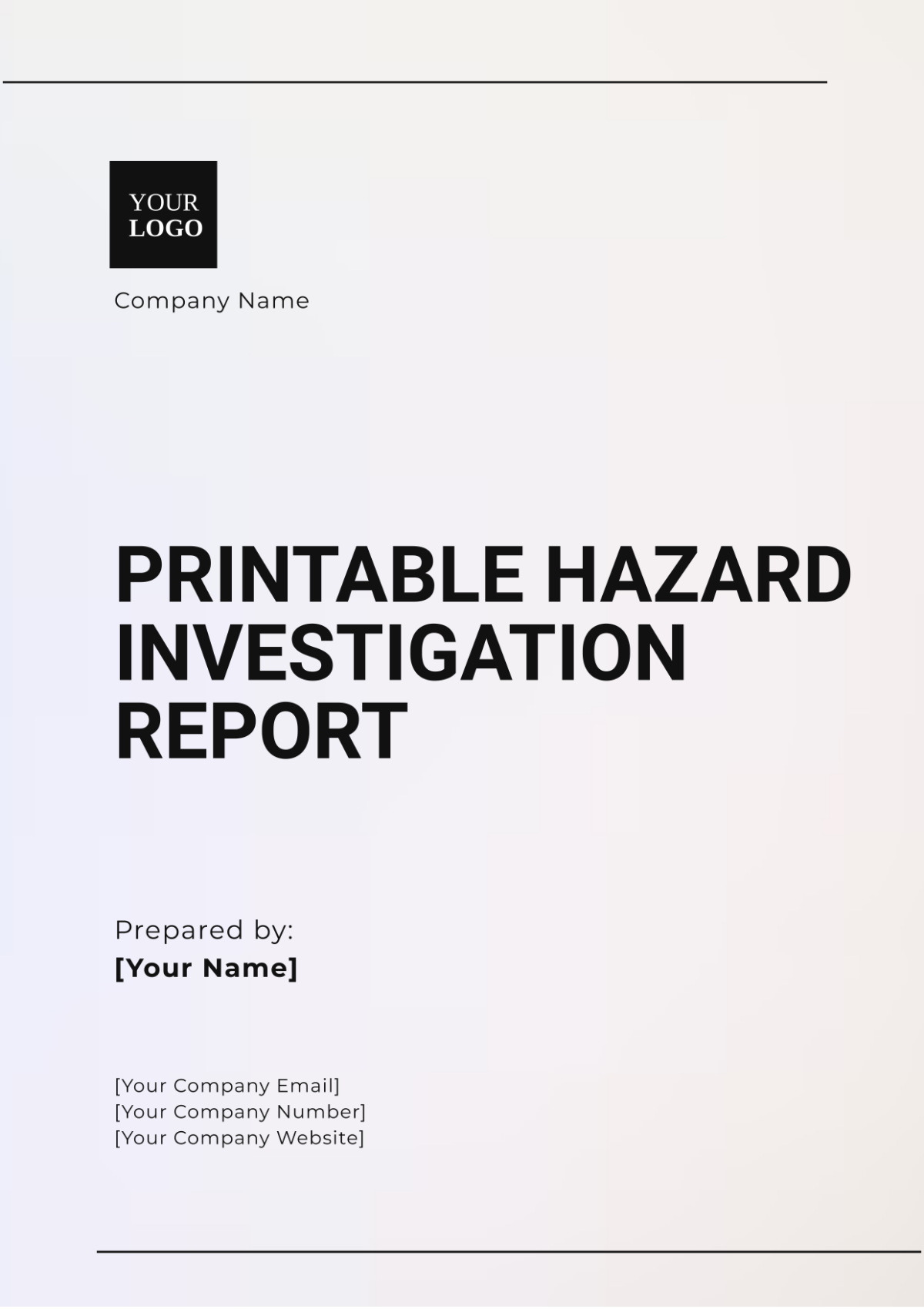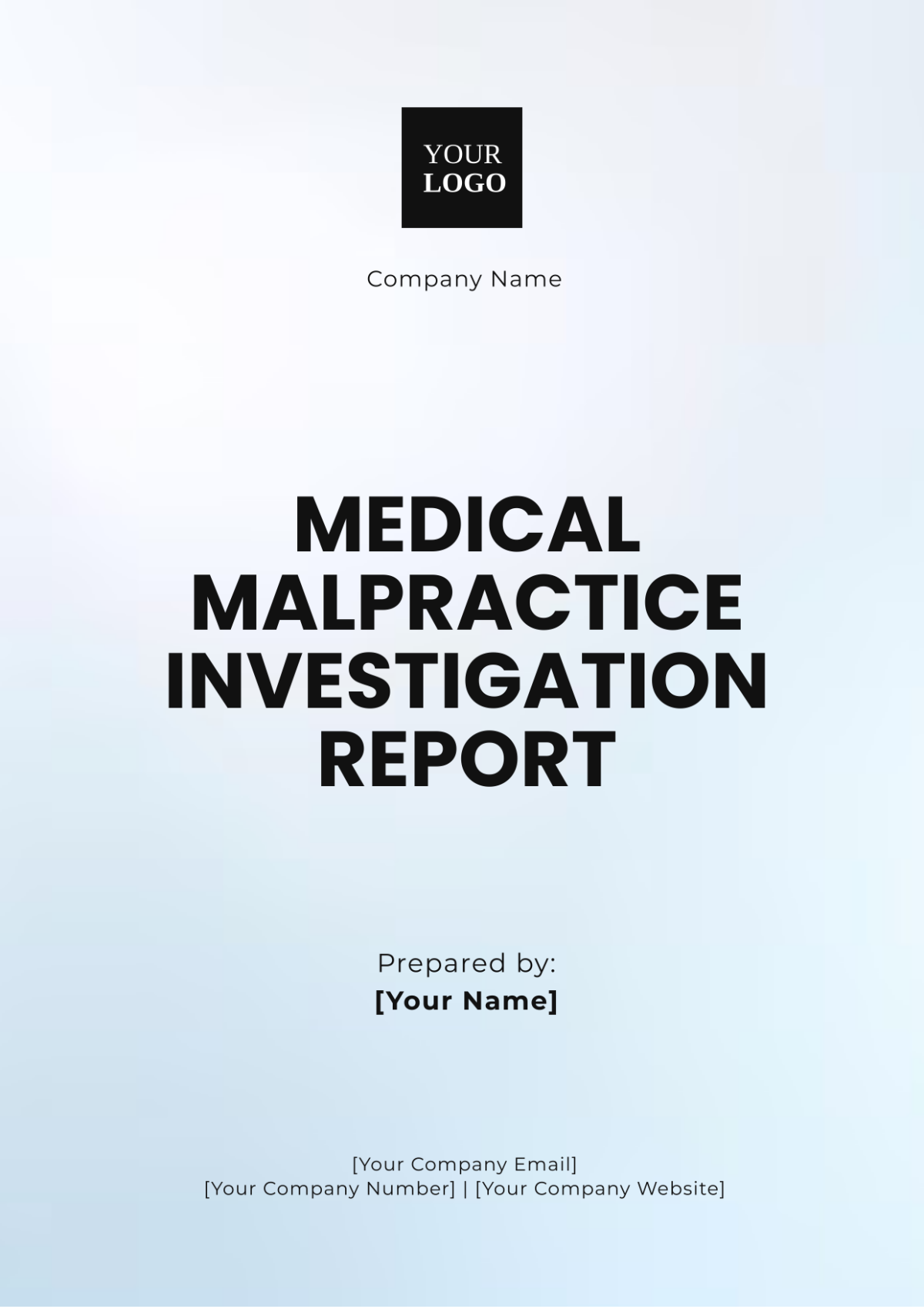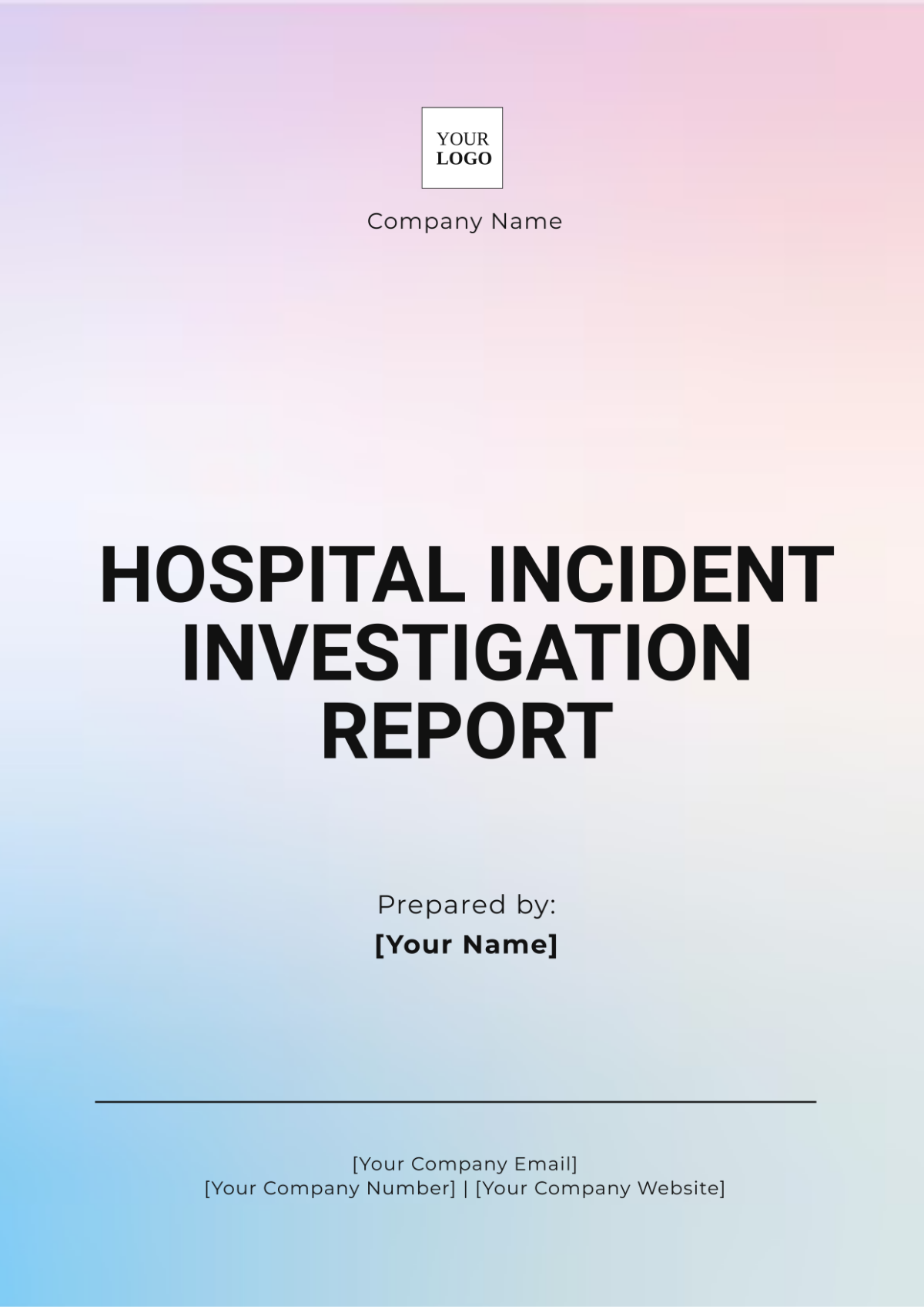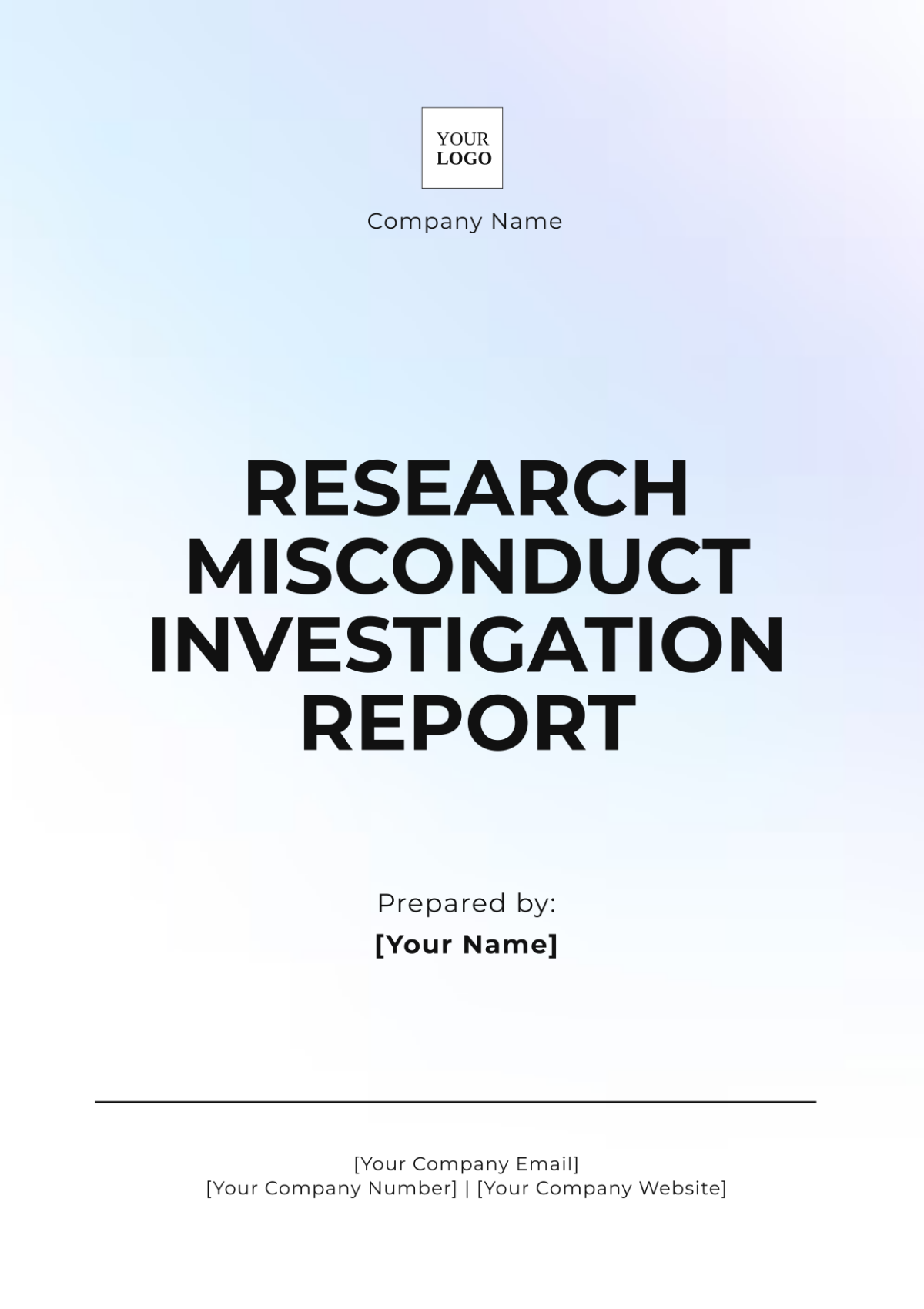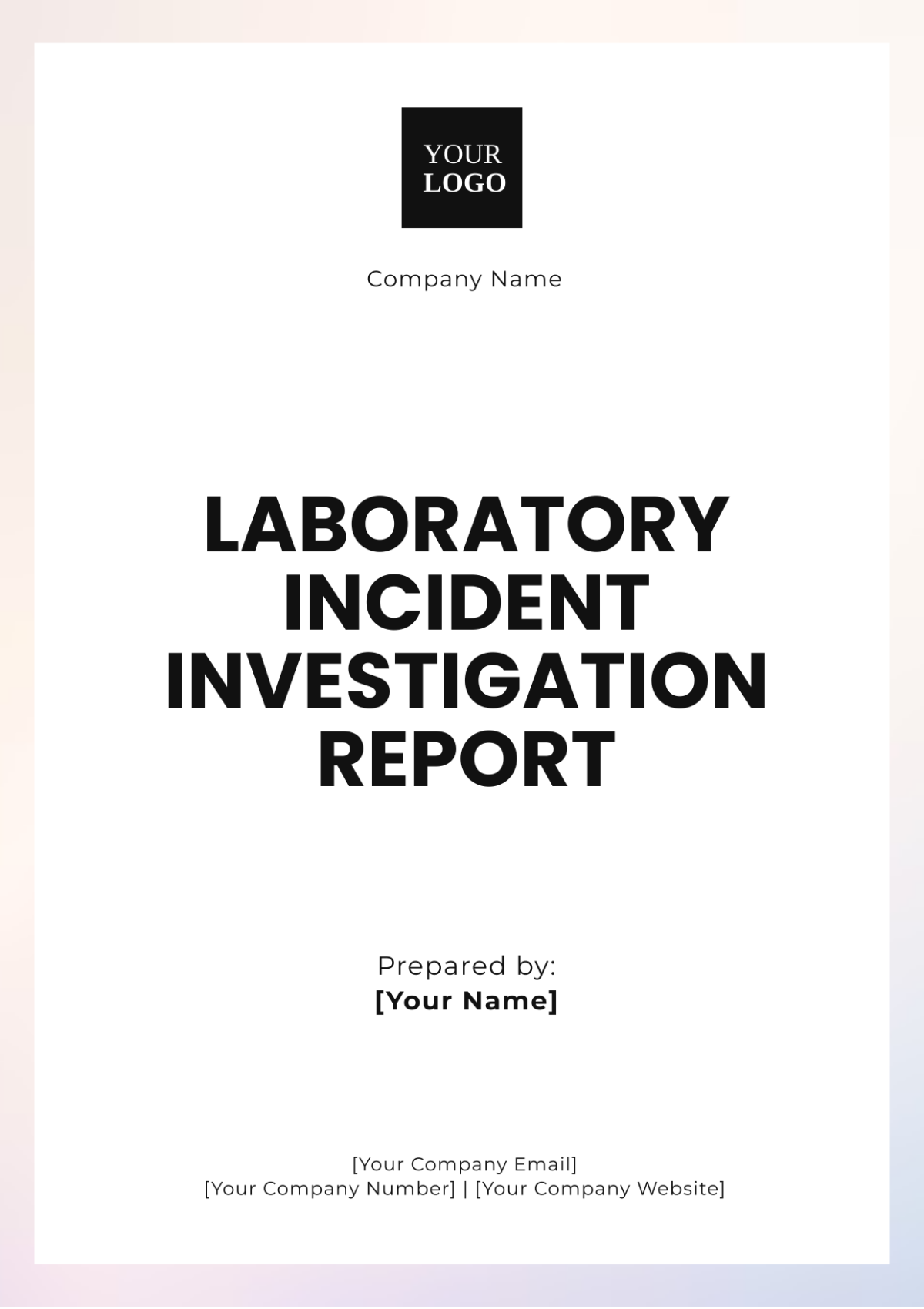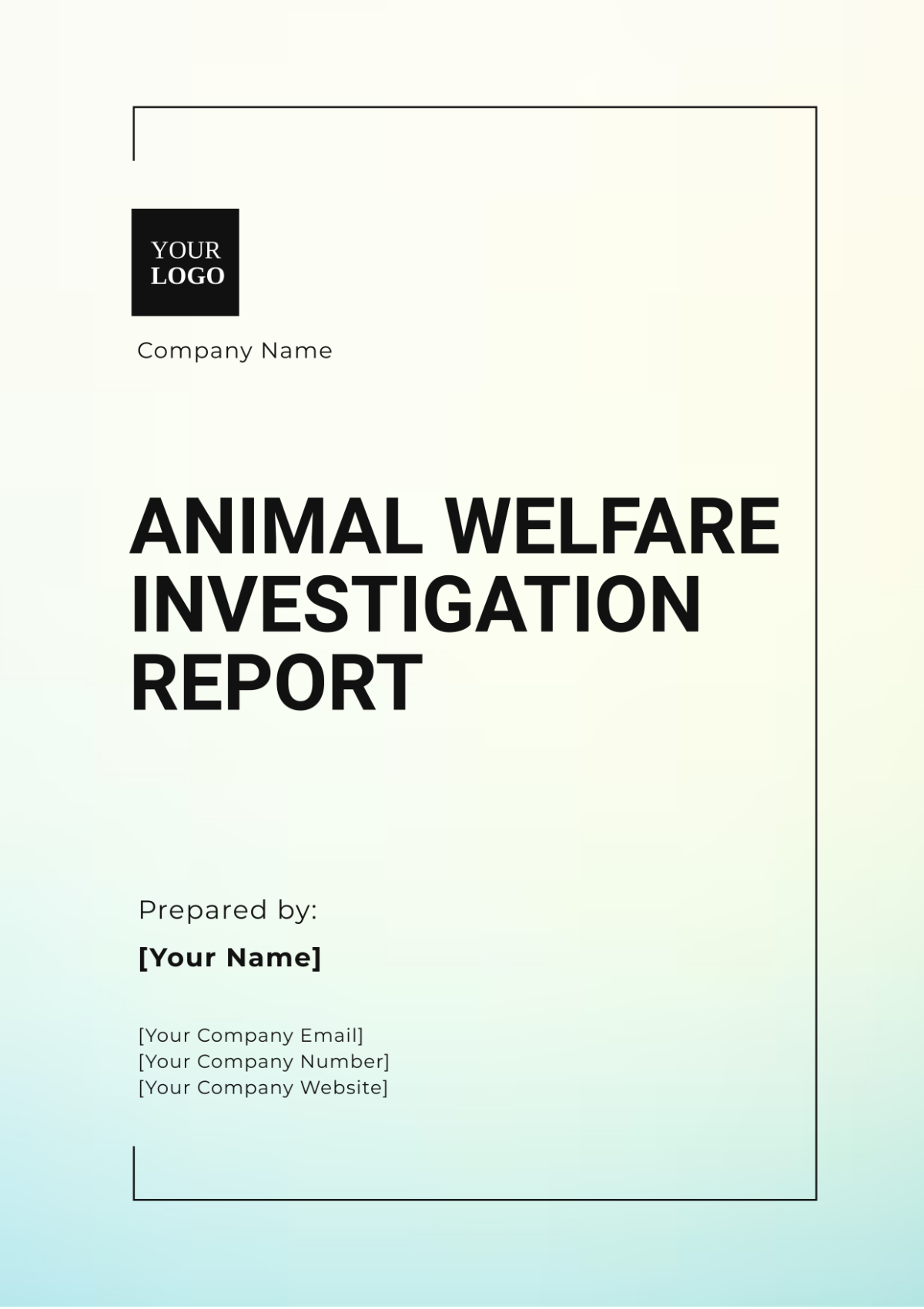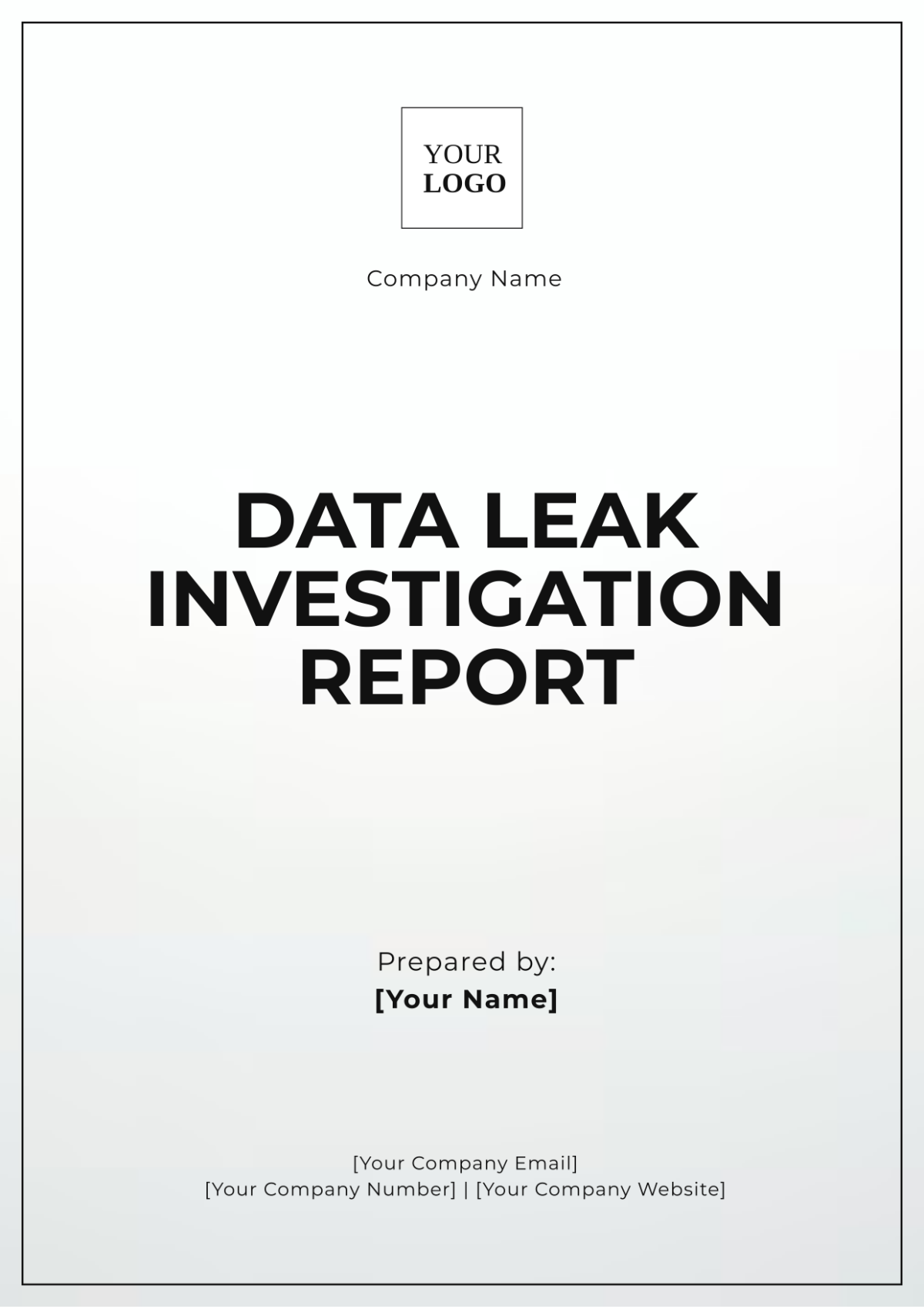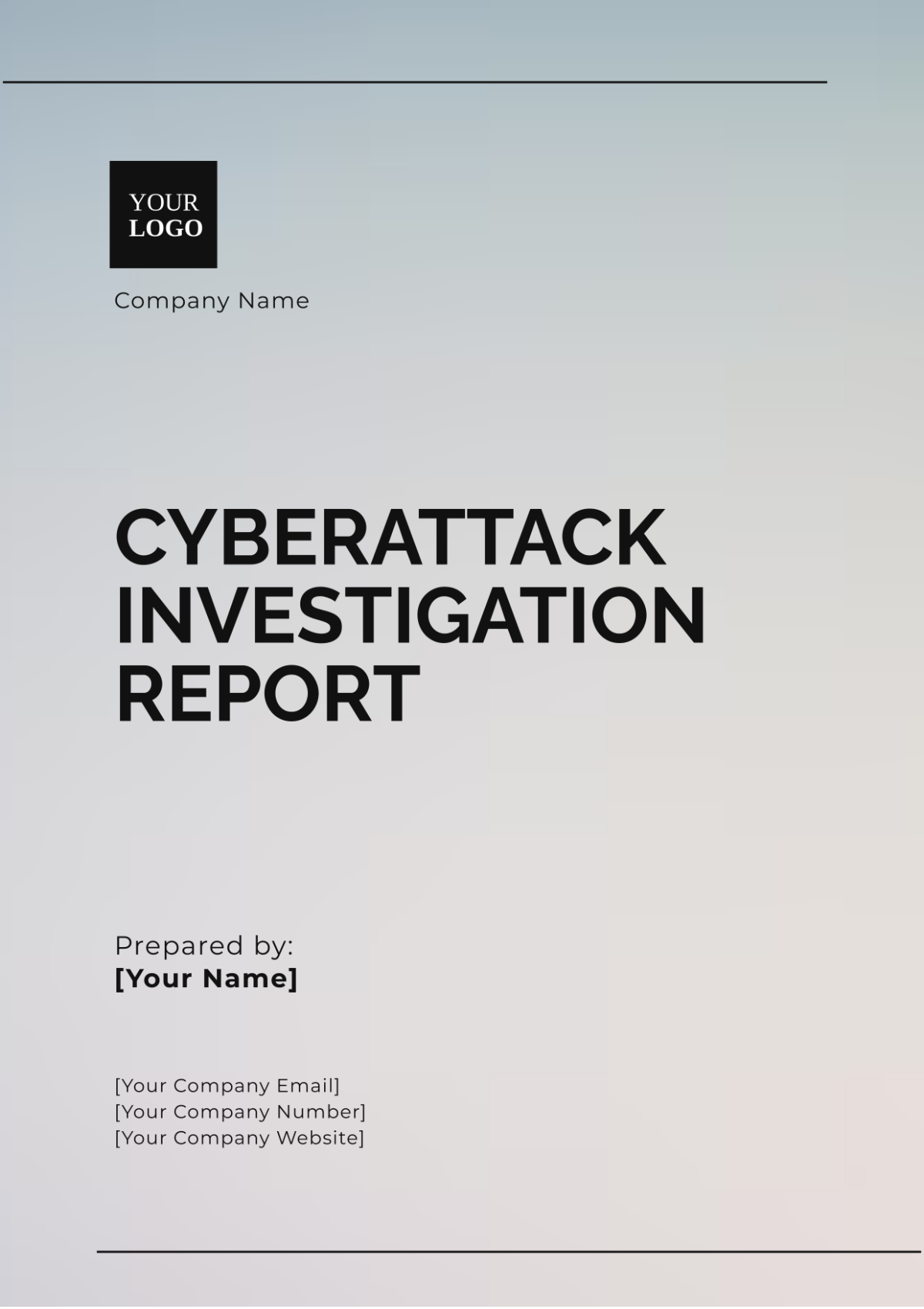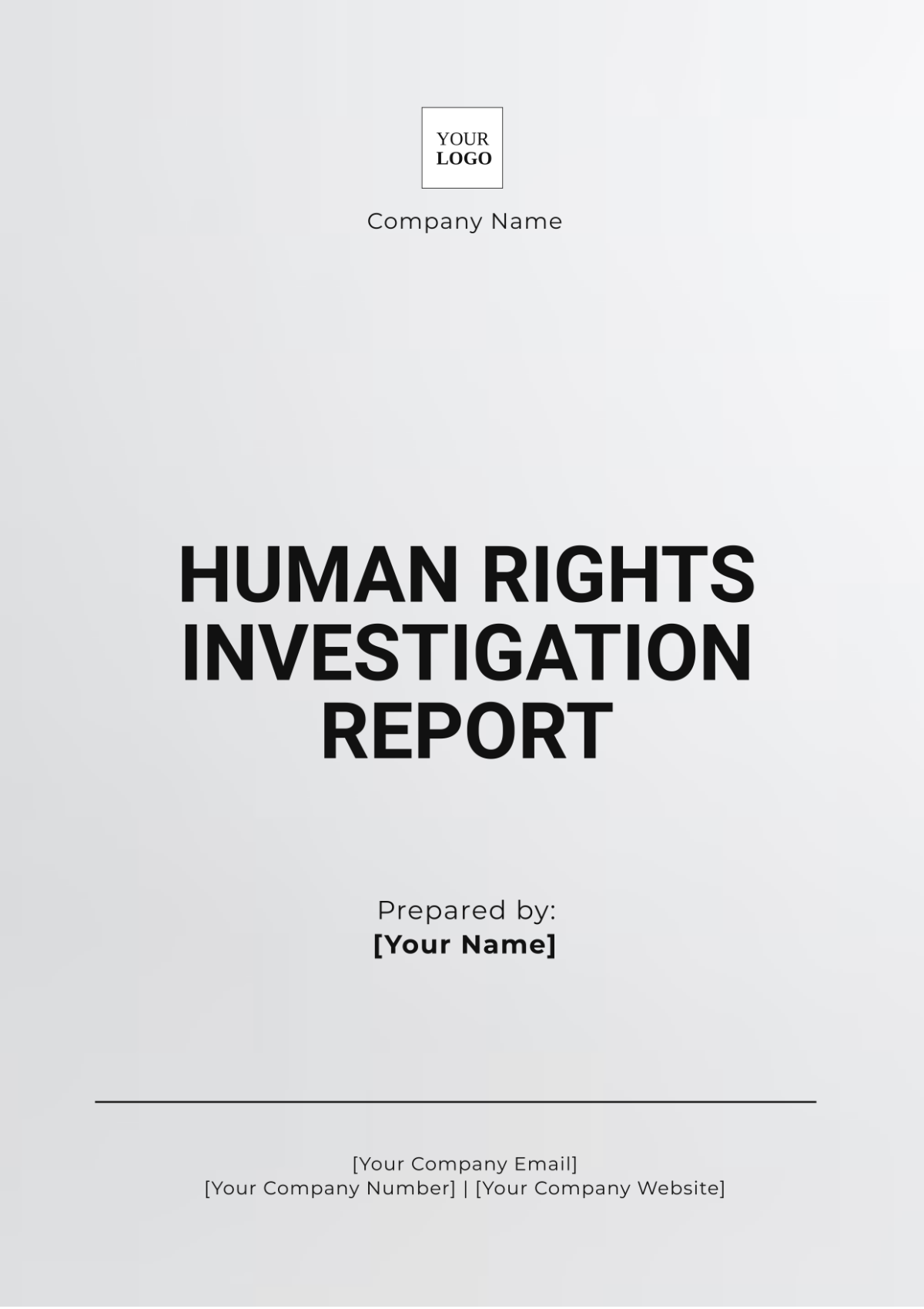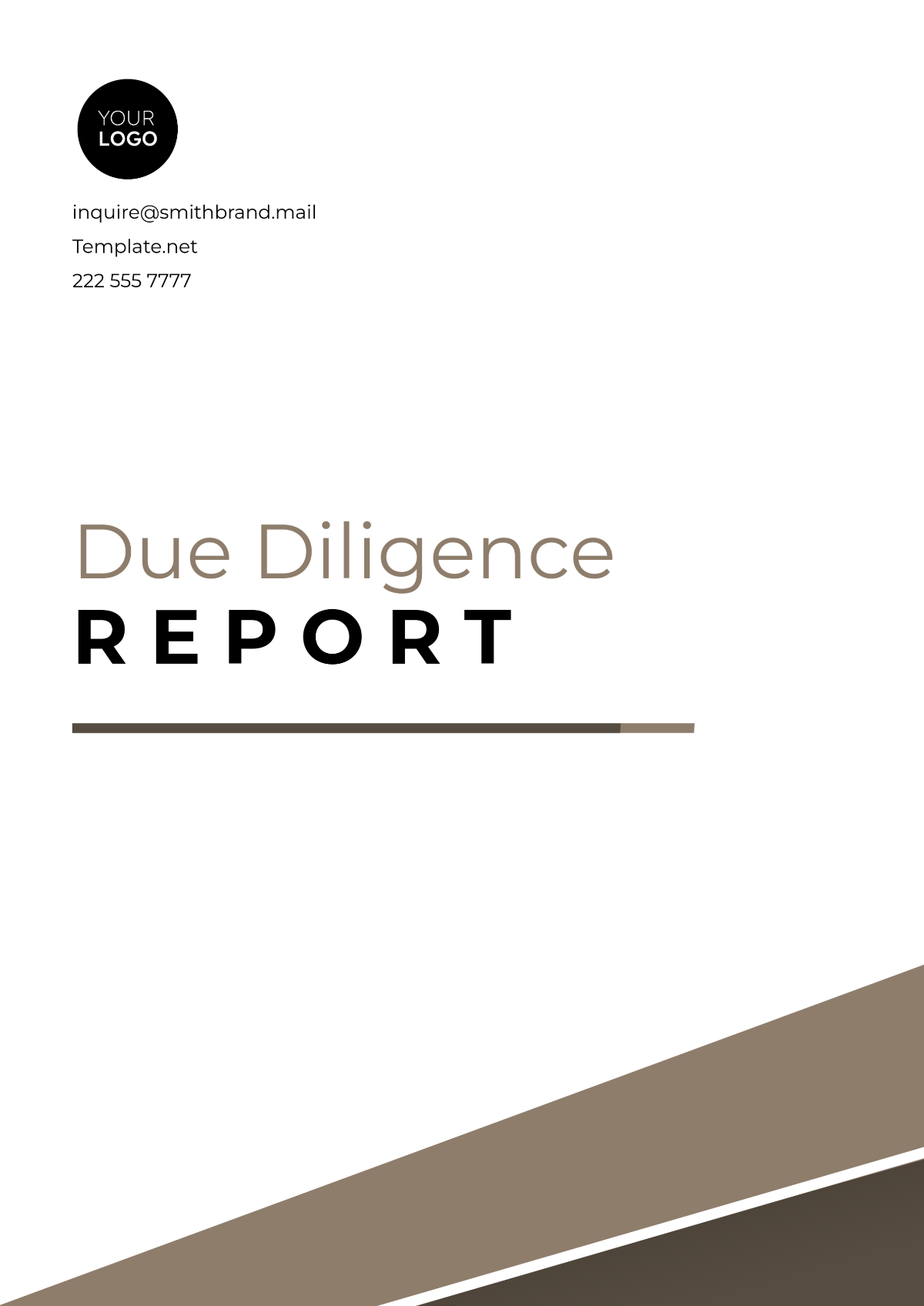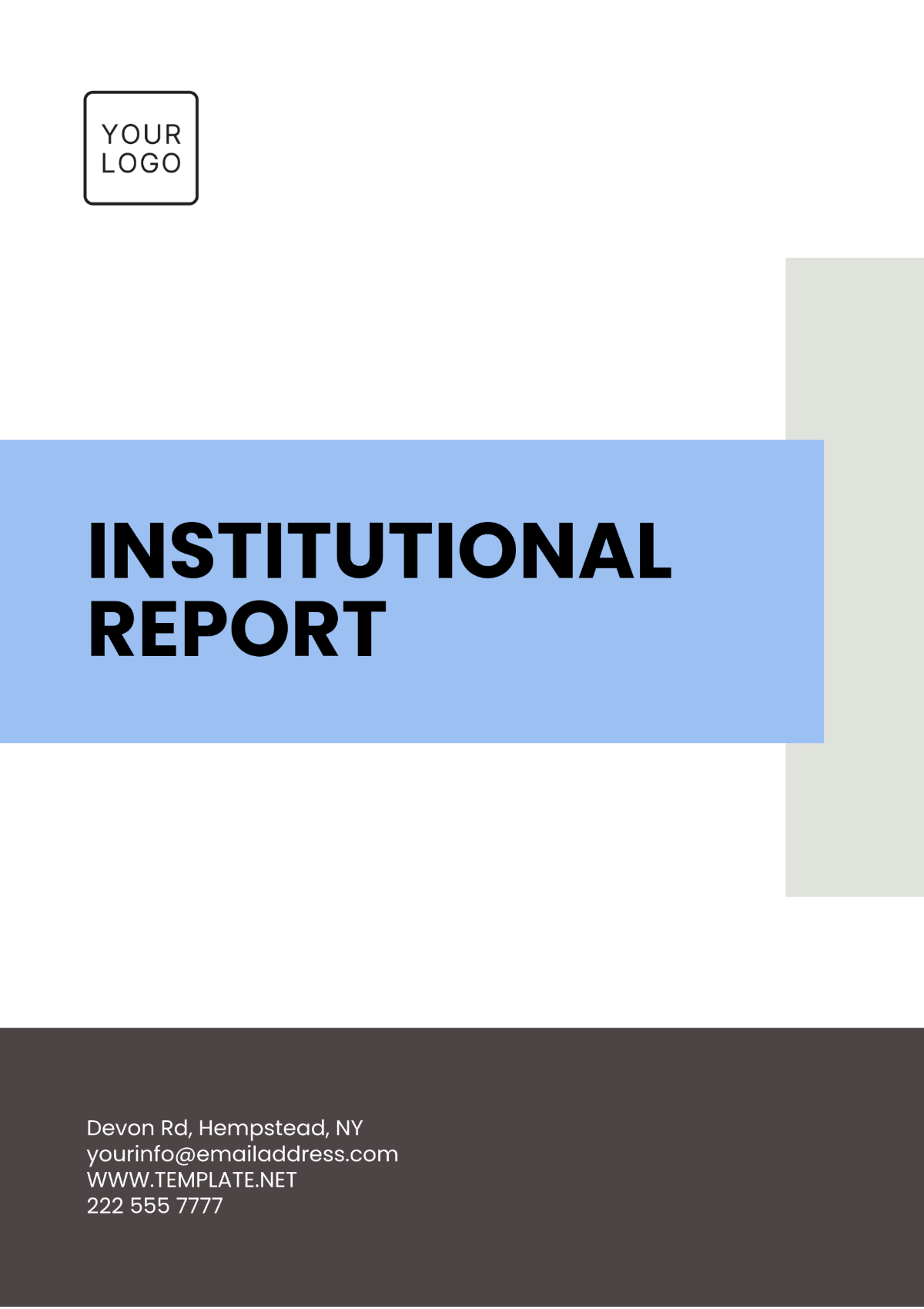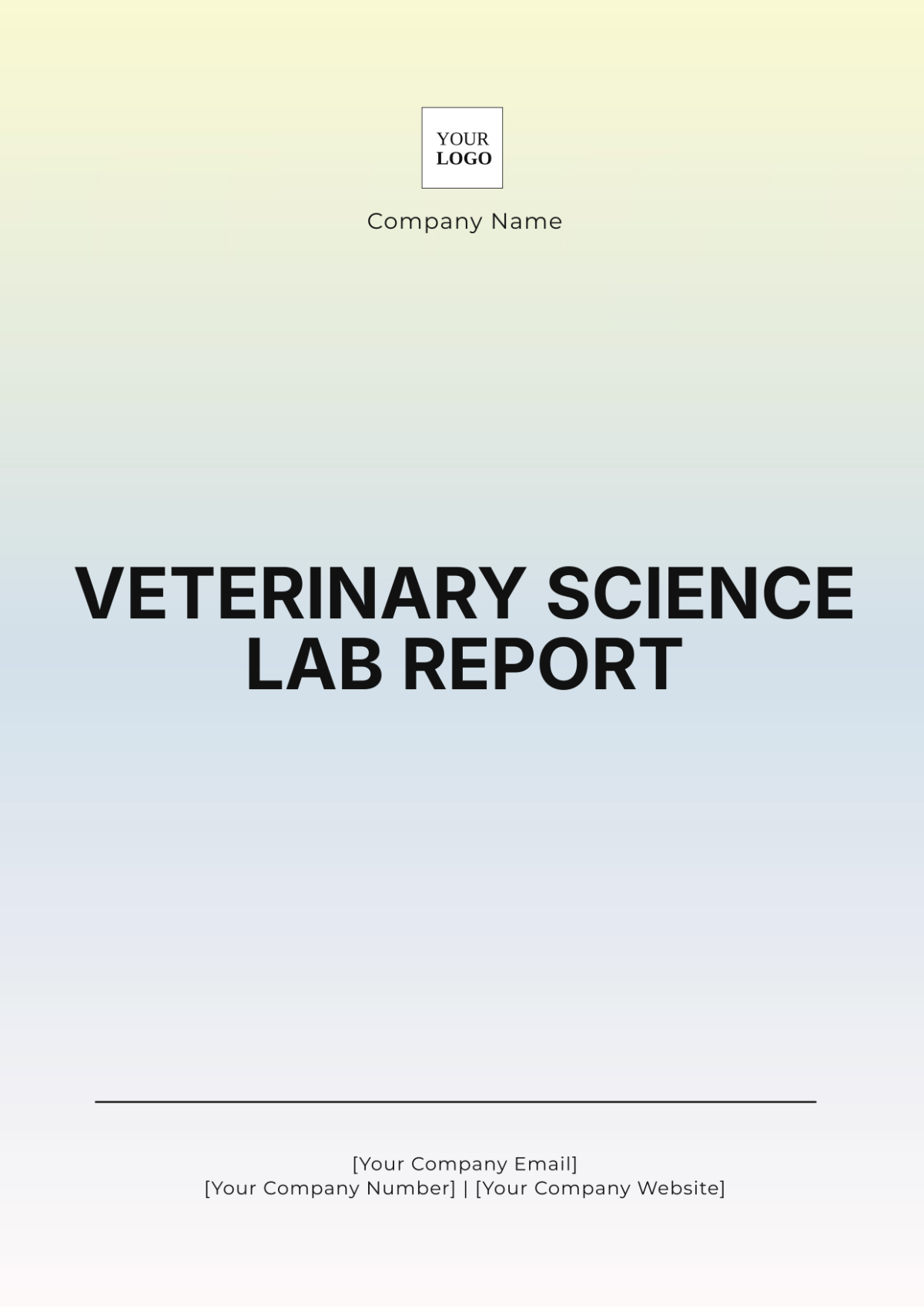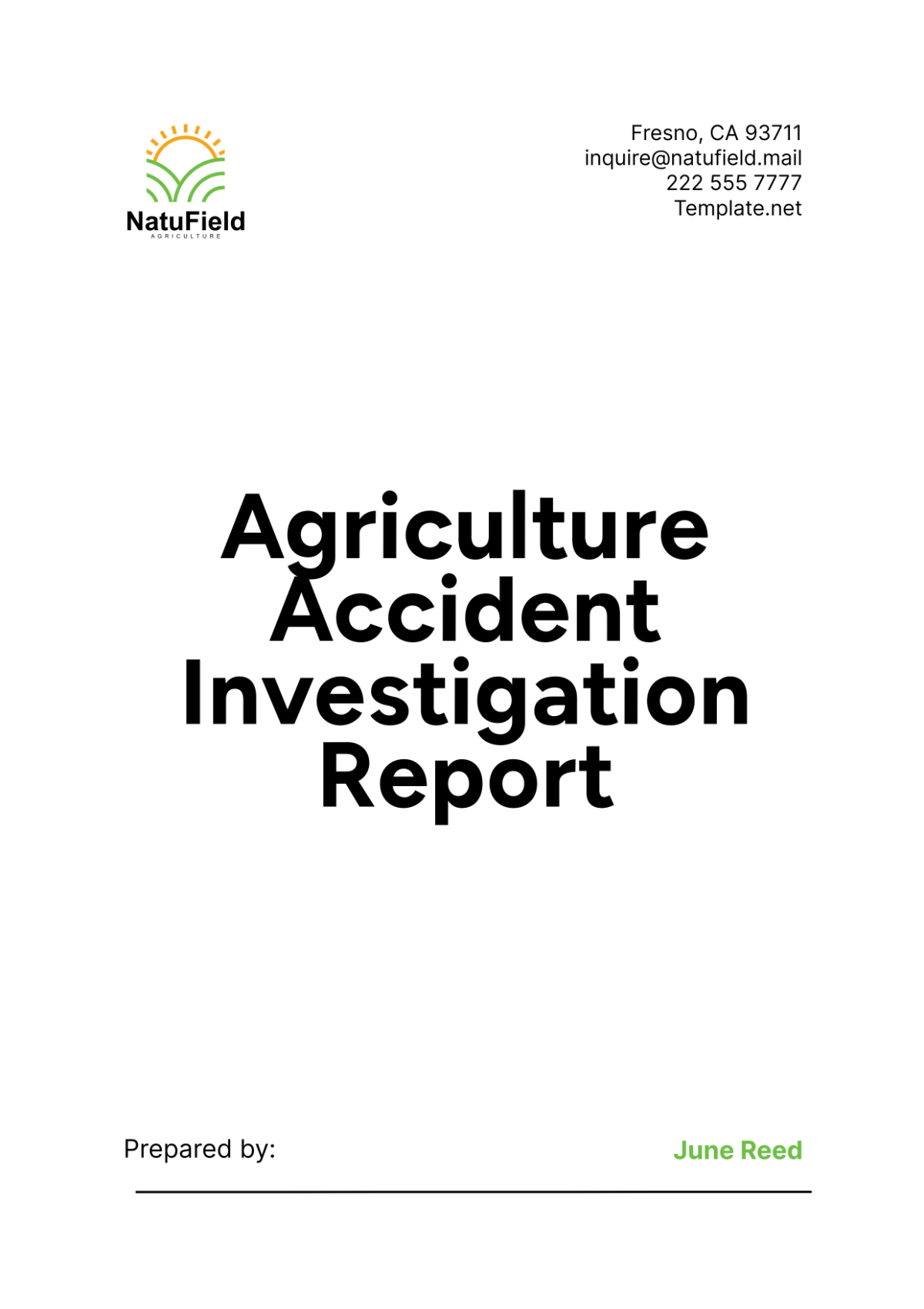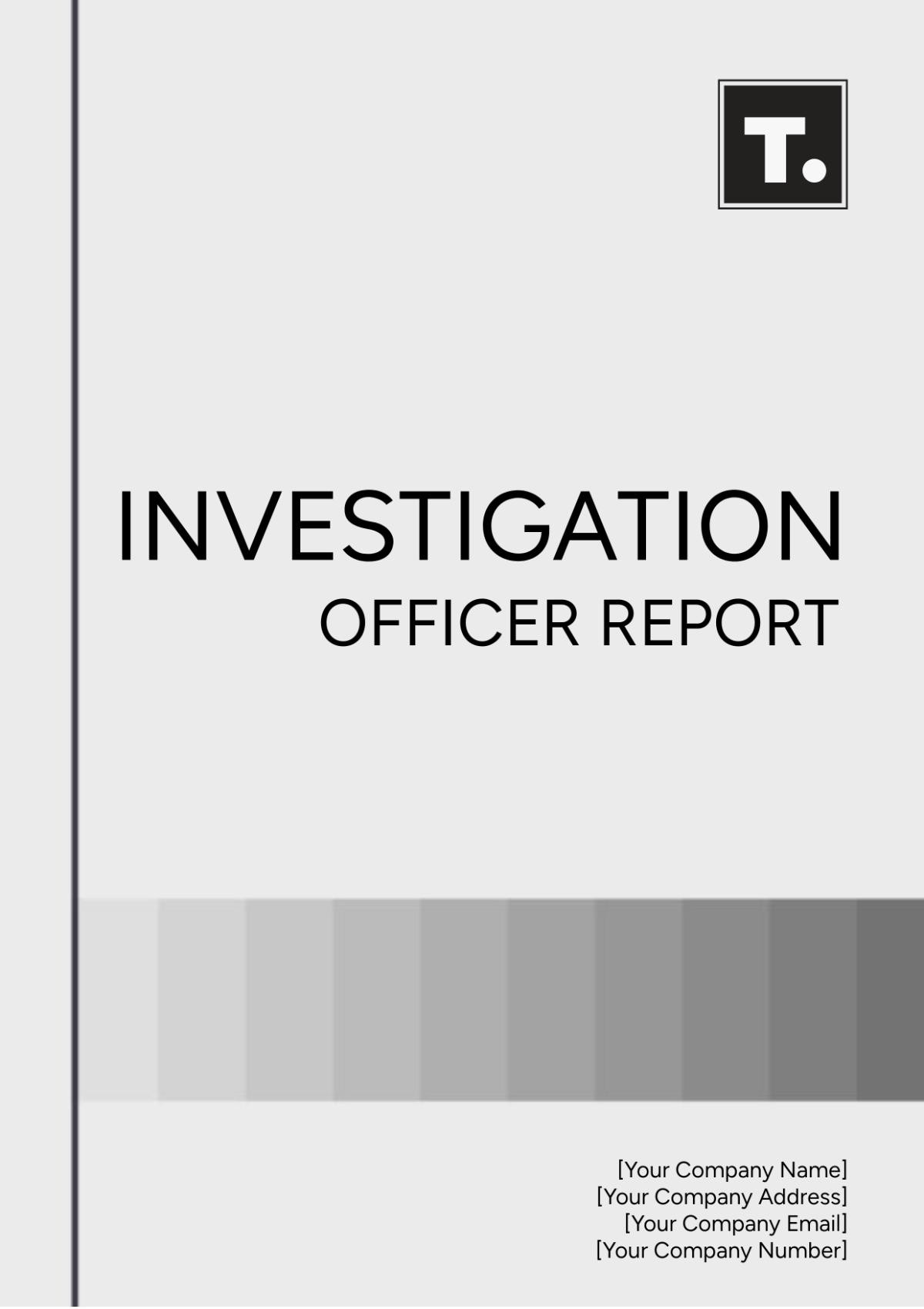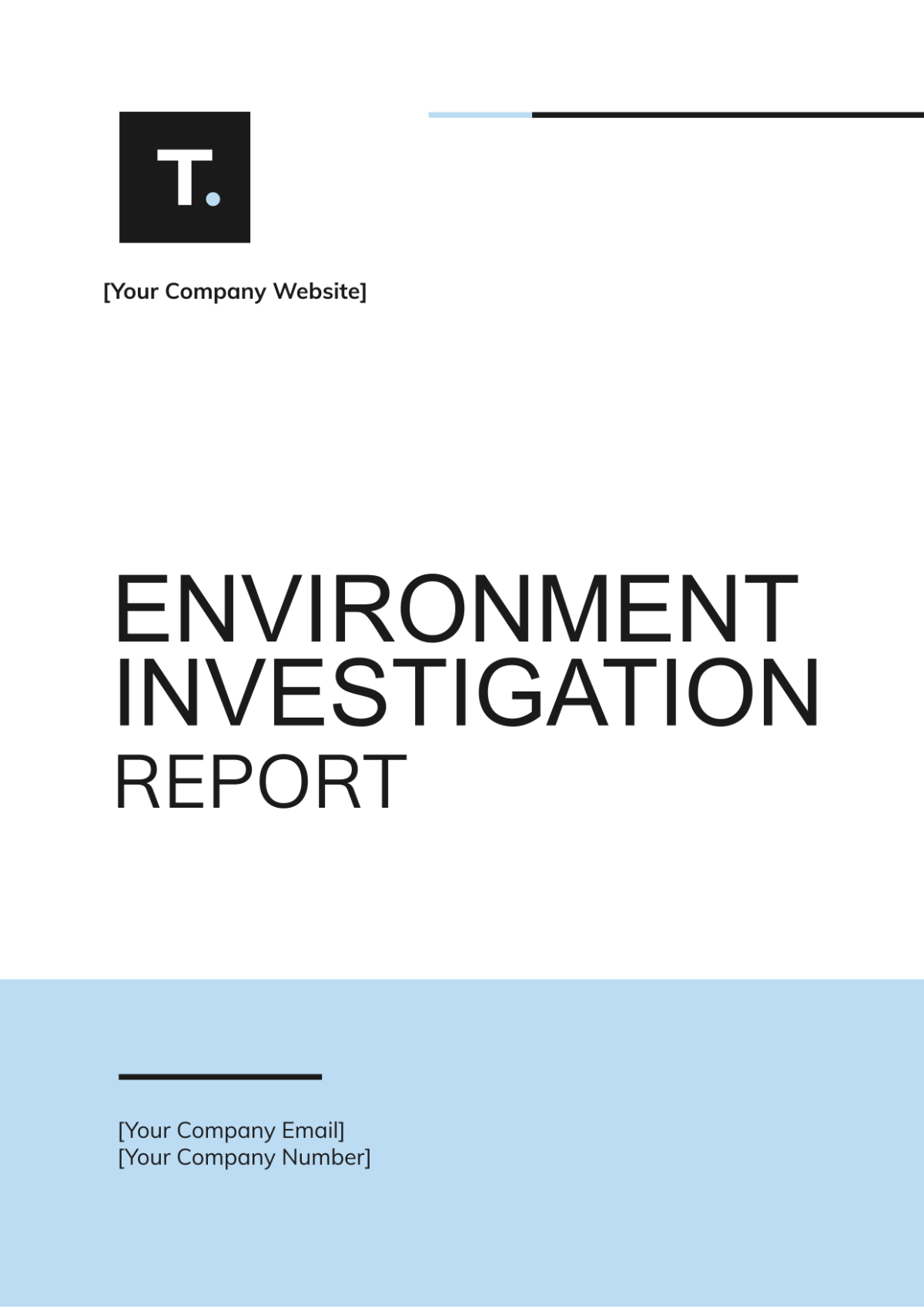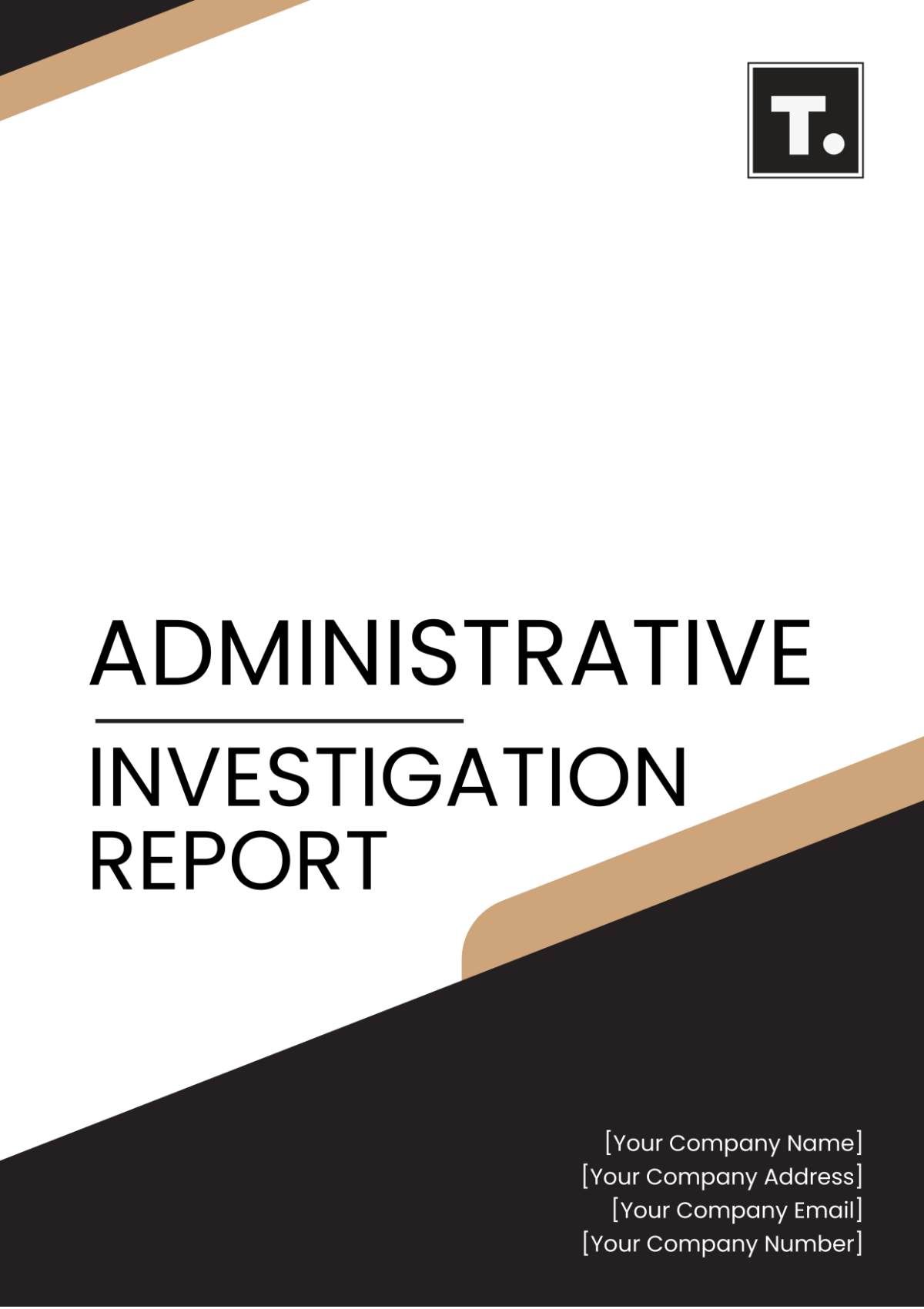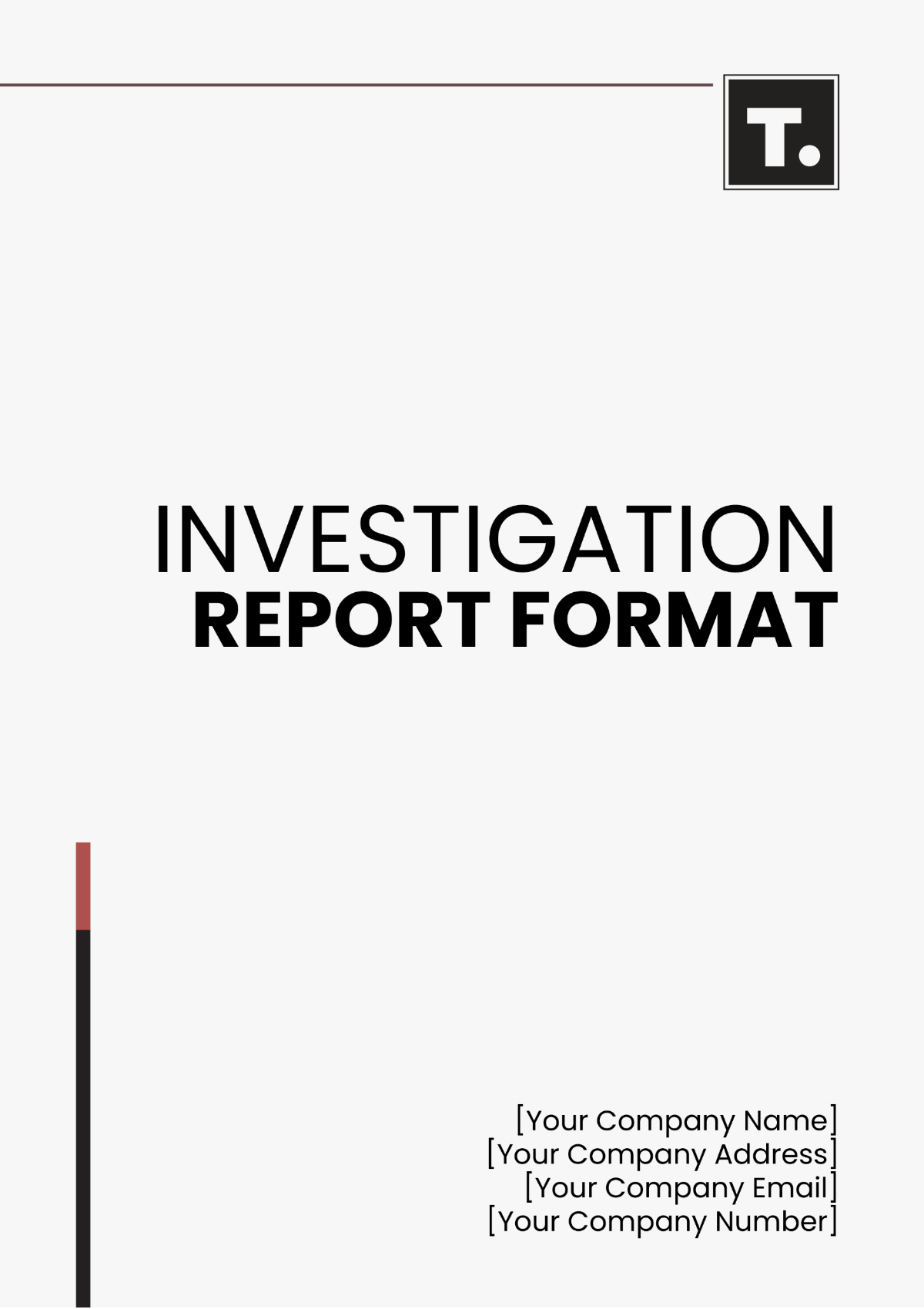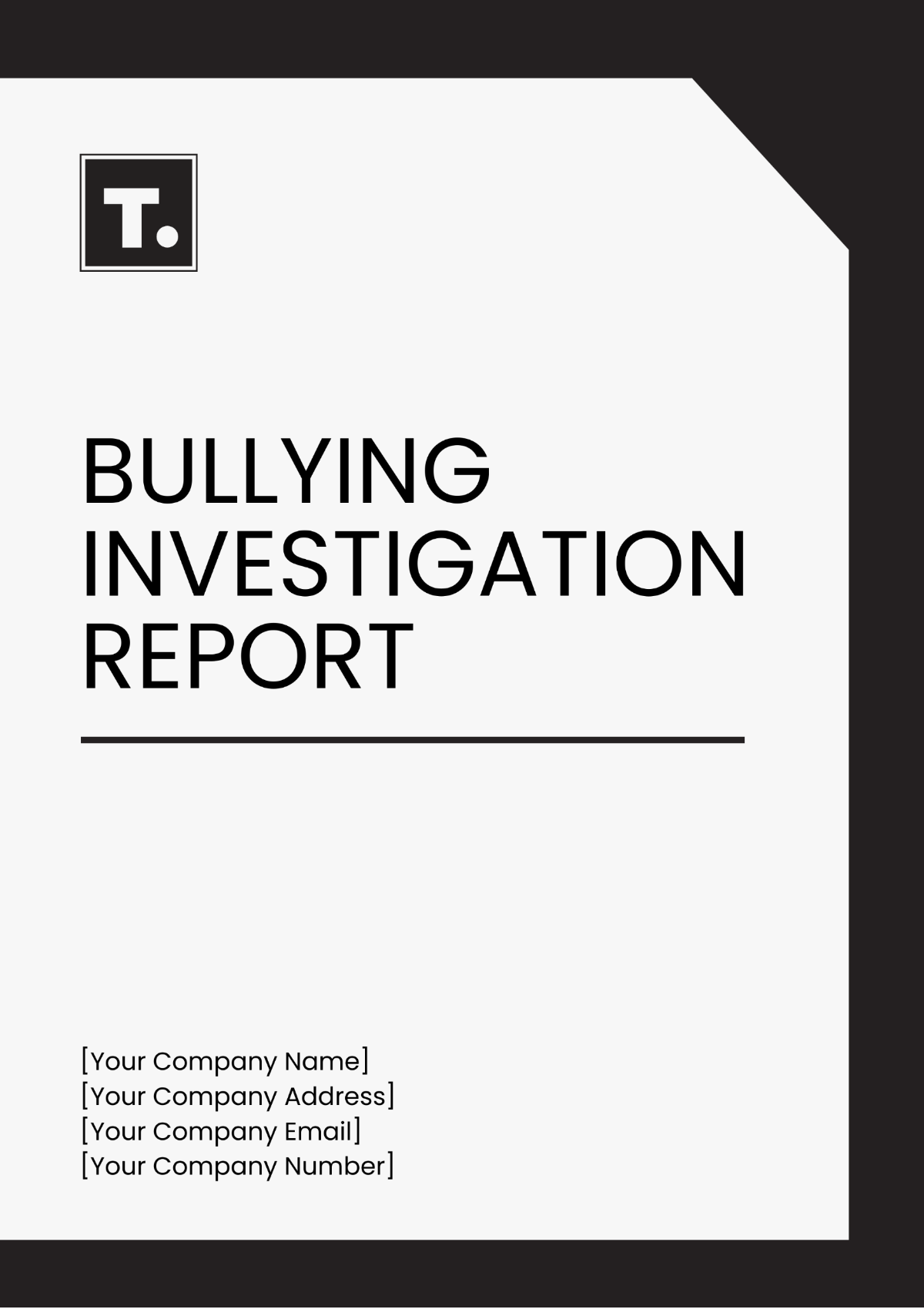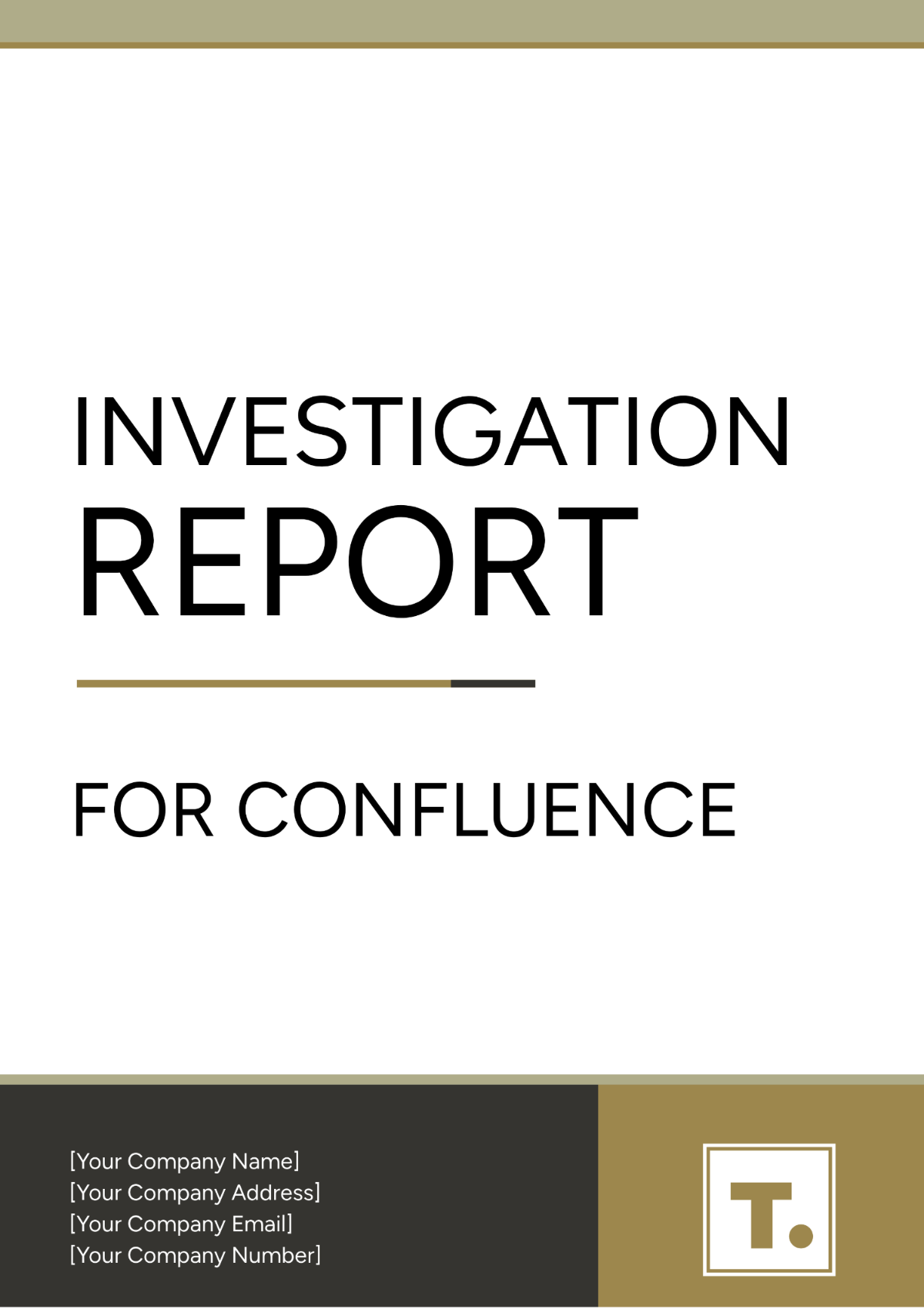Investigative Report Chapter Outline
Prepared by: [Your Name]
Date: [Date]
I. Introduction
The Introduction plays a crucial role in laying the groundwork for the entire investigative report by clearly defining and articulating the purpose of the investigation, setting forth the scope that it will cover, establishing the specific objectives that it aims to achieve, and identifying and outlining the key issues that will be addressed throughout the investigation.
A. Purpose
The purpose of this investigation is to identify and understand financial discrepancies within Acme Corporation’s accounting practices. Specifically, the investigation aims to:
Uncover the nature and extent of financial irregularities.
Evaluate the effectiveness of current internal controls and approval processes.
Assess the potential impact of these issues on the company’s financial statements and regulatory compliance.
Provide recommendations for corrective actions and improvements.
B. Scope
This investigation focuses on:
Time Frame: Financial transactions from January 2072 to June 2074.
Departments: The accounting department, including expense reporting, invoice processing, and vendor management.
Exclusions: Transactions before January 2072, and financial activities in departments other than accounting.
Geographical Scope: Transactions and processes within the main office and regional branches, but excludes international operations.
C. Objectives
The specific objectives of this investigation are:
Identify Discrepancies: Detect and quantify any anomalies in expense and payment records.
Evaluate Internal Controls: Assess the effectiveness and adherence to internal controls and approval processes related to financial transactions.
Assess Impact: Determine the effect of discrepancies on the accuracy of financial statements and compliance with regulatory standards.
Provide Recommendations: Offer actionable recommendations to address identified issues and strengthen financial oversight and control mechanisms.
D. Key Issues
The investigation focuses on the following key issues:
Expense Reporting Irregularities: Unusual patterns in expense reports, including unapproved or duplicate claims.
Invoice Approval Failures: Instances where invoices were processed without proper authorization or documentation.
Unauthorized Vendor Payments: Payments made to vendors not listed in the approved vendor database.
Regulatory Compliance: Adherence to financial reporting standards and legal requirements.
II. Background Information
This part of the document offers crucial background information necessary for comprehending the investigation. It achieves this by detailing pertinent historical events, summarizing findings from prior research, and furnishing relevant background data.
A. Historical Context
Acme Corporation, established in 2050, has grown from a small startup to a major player in its industry. The company faced financial irregularities in 2055, which led to a comprehensive internal audit and subsequent reforms in financial reporting procedures. Recent concerns about similar issues resurfacing prompted this investigation.
B. Previous Studies or Reports
2055 Internal Audit Report: Revealed significant deficiencies in expense reporting and approval processes. Recommendations included tightening controls and implementing a more rigorous approval system.
2061 External Audit Report: No major issues were reported, but the audit highlighted potential areas for improvement in invoice processing and compliance with updated financial standards.
C. Background Data
Expense Trends: An analysis of recent financial data shows a 20% increase in travel expenses and a 15% increase in office supply costs compared to the previous fiscal year. Such trends may indicate inefficiencies or potential misuse.
Approval Workflow Issues: Internal reviews revealed that approximately 25% of expense reports lacked proper approval signatures, raising concerns about adherence to established procedures.
III. Findings
This section provides a comprehensive account of the investigation's results. It includes an extensive overview of the data collected throughout the investigation as well as the observations made by the research team.
A. Data Collection Methods
Data was gathered through various methods:
Document Review: Comprehensive examination of financial records, including expense reports, invoices, payment transactions, and approval logs.
Interviews: Conducted with key personnel, including accounting staff, department heads, and vendors, to gather insights into financial processes and control practices.
Workflow Analysis: Evaluation of the approval workflows and controls implemented in the accounting department to identify gaps and inefficiencies.
B. Key Findings
Travel Expense Discrepancies: Discrepancies totaling $150,000 were identified in travel expense claims, including duplicate claims and unsupported expenses.
Unauthorized Payments: $50,000 in payments were made to vendors not listed in the approved vendor database, suggesting lapses in vendor management.
Approval Workflow Failures: Approximately 30% of expense reports were processed without required approvals or supporting documentation, indicating systemic issues in the approval process.
C. Evidence and Observations
Travel Expense Reports: Evidence includes copies of expense reports with duplicate entries, missing travel itineraries, and insufficient documentation for claims.
Vendor Payments: Records of payments to unauthorized vendors, including invoices and payment confirmations, demonstrate a lack of proper vetting and approval.
Staff Interviews: Testimonies from staff reveal a lack of awareness about updated expense policies and inconsistencies in the application of approval procedures.
IV. Analysis
The Analysis section serves the crucial role of interpreting the findings gathered during the investigation. It goes beyond merely presenting the data or results, delving deeply into their meaning and implications. This section seeks to elucidate the significance of these findings by placing them within the broader context of the research objectives.
A. Data Interpretation
Travel Expense Discrepancies: The repeated discrepancies in travel expenses suggest potential fraudulent activities or significant breakdowns in expense reporting procedures.
Unauthorized Payments: Payments to unregistered vendors indicate weaknesses in the vendor management system, which could expose the company to fraud or mismanagement risks.
B. Correlation with Objectives
Identifying Discrepancies: The findings directly address the objective of identifying financial discrepancies, with significant anomalies found in travel expenses and vendor payments.
Evaluating Controls: The analysis of approval workflows and controls highlights deficiencies that align to evaluate internal controls.
C. Significant Patterns
Expense Reporting Patterns: The data reveals a pattern of repeated discrepancies in travel expenses and approval process failures, indicating systemic issues rather than isolated errors.
Vendor Management: The consistent occurrence of payments to unauthorized vendors suggests a recurring problem with vendor management practices.
V. Conclusions
In this section, a comprehensive summary of the investigation's key findings is presented, providing detailed answers to the research questions posed earlier. Additionally, a thorough discussion of the broader implications of these findings is conducted, offering insights into the wider significance and potential impact of the research.
A. Summary of Findings
Financial Irregularities: The investigation revealed $200,000 in discrepancies, including $150,000 in travel expenses and $50,000 in unauthorized vendor payments.
Control Failures: Significant weaknesses in internal controls and approval processes were identified, contributing to the financial issues.
B. Answer to Key Issues
Expense Reporting: Irregularities in expense reporting were substantiated by evidence of duplicate claims and unsupported expenses, indicating possible fraudulent activities or process failures.
Invoice Approvals: The investigation confirmed lapses in invoice approval processes, raising concerns about compliance with financial controls.
Vendor Payments: Unauthorized payments to vendors highlight deficiencies in vendor management and oversight procedures.
C. Implications
Financial Impact: The identified discrepancies may affect the accuracy of financial statements and lead to potential legal and regulatory consequences.
Regulatory Compliance: Non-compliance with financial reporting standards could result in reputational damage and increased scrutiny from regulators.
VI. Recommendations
The section offers detailed and practical advice that can be implemented, all derived from the thorough findings and comprehensive analysis carried out during the investigation.
A. Immediate Actions
Comprehensive Audit: Conduct a thorough audit of all financial transactions from the past 12 months to identify and correct any discrepancies.
Expenditure Freeze: Implement a temporary halt on non-essential spending until new approval processes and controls are established.
B. Long-term Strategies
Revise Internal Controls: Develop and implement more stringent internal controls and approval procedures to prevent future discrepancies and enhance financial oversight.
Training and Awareness: Provide comprehensive training for all staff on updated financial policies and procedures to ensure adherence to best practices and regulatory requirements.
C. Areas for Further Research
Fraud Investigation: Explore potential links between financial discrepancies and employee activities to determine if there is evidence of fraud or misconduct.
Effectiveness of Previous Reforms: Evaluate the effectiveness of corrective actions taken after the 2055 audit to ensure that they are achieving the desired results and preventing similar issues.
VII. Appendices
The section encompasses a variety of supplementary materials that serve to bolster and substantiate the main findings and recommendations presented within the primary body of the document.
A. Raw Data
Expense Reports: Complete and detailed records of all expense reports reviewed during the investigation, including those with identified discrepancies.
Vendor Invoices: Copies of invoices with noted issues and discrepancies, along with supporting payment records.
B. Detailed Calculations
Expense Discrepancies Breakdown: Detailed calculations of the $150,000 in travel expense discrepancies, including analyses of duplicate claims, unsupported expenses, and calculation methods.
Vendor Payment Analysis: Summary of unauthorized vendor payments, including amounts, documentation, and analysis of payment patterns.
C. Additional Resources
Approval Workflow Documentation: Samples and diagrams of approval workflows and financial policies used during the investigation to illustrate procedural gaps and recommended improvements.
Interview Transcripts: Full transcripts of interviews with accounting staff, department heads, and other key personnel, providing insights into internal processes and areas of concern.
